Offshore wind to green hydrogen: opportunity assessment
Initial assessment of Scotland’s opportunity to produce green hydrogen from offshore wind.
3 scotland’s green hydrogen potential
3.1 Introduction
Scotland has both a sizeable offshore wind resource, and an extensive offshore and coastal infrastructure and supply chain associated with the long-established oil and gas industry. These are supported by world-class universities and research centres, and innovative energy solution providers.
This section considered the potential of this resource, infrastructure and supply chain to be utilised for green hydrogen production. The following opportunities are examined:
- Analysis of Scotland’s offshore wind resource potential that could be leveraged for green hydrogen production in future.
- The potential suitability of repurposing existing O&G pipelines in the North Sea for transportation of hydrogen, in particular to connect Scotland to Europe to export clean hydrogen to demand hubs in densely populated hubs in Northern Europe.
- The potential suitability of existing terminal and ports for ship-based export of hydrogen
- The current state of the Scottish supply chain to support green hydrogen production.
3.2 Hydrogen Production Modelling
Three development scenarios of offshore wind energy capacity have been developed across the timescales of 2025, 2032 and 2045, to help inform the modelling of the potential amount of hydrogen that could be produced from offshore wind energy in Scotland.
The offshore wind potential was used to create 2045 net-zero scenarios to enable calculation of the amount of green hydrogen (GWh/year) that could be produced from offshore wind to meet Scotland’s hydrogen demand evaluated in Chapter 2, and export surplus hydrogen to the rest of Europe to meet hydrogen demand of the identified hubs outside of Scotland.
This section is focused on creating credible scenarios related to green hydrogen production from offshore wind and highlights Scotland’s potential to become a green hydrogen exporter in the future, which is further assessed in Chapter 4.
3.2.1 Scotland’s Offshore Wind Projections
The offshore wind projections between 2020 and 2045 are based on the following scenarios;
- Ambitious Scenario: The most ambitious green hydrogen production scenario in 2025, 2032 and 2045, if multiple leasing rounds in Scotland were undertaken ahead of 2045 and development was promoted beyond the current net-zero targets.
- Planned Development Scenario: Optimistic but credible green hydrogen production scenario based on a high capacity of ScotWind leasing and realistic subsequent future offshore wind developments being realised. In addition to the offshore wind development, the roadmap for this scenario assumed political support for green hydrogen production, use and export.
- Business as Usual Scenario: Conservative scenario with Scottish offshore wind development continuing at modest pace with limited green hydrogen technology uptake and no additional policy support.
The scenarios have been based on current offshore wind farm policies and targets (apart from the 2045 ambitious scenario which assumes multiple leasing rounds that have not been confirmed to date). They do not represent the total capacity possible if policy was to change or if the entire seabed was to be made available for development.
The capacity values estimated include the current capacity available from fully commissioned offshore wind farm projects estimated at ~900 MW (see Table 3.1). The scenarios produced have not considered the potential for Offshore Wind Farms (OWFs) to secure consent or a CfD or another financial agreement.
| Current Scottish Offshore Wind Farms | Phase | Capacity (max) | Current operational OWF capacity | Projects included in 2025 scenario | ||
|---|---|---|---|---|---|---|
| Business as usual | Planned development | Ambitious | ||||
| Aberdeen Offshore Wind Farm (EOWDC) | Fully Commissioned | 93.2 | ||||
| Beatrice | Fully Commissioned | 588 | ||||
| Hywind Scotland Pilot Park | Fully Commissioned | 30 | ||||
| Kincardine - Phase 1 | Fully Commissioned | 2 | ||||
| Levenmouth demonstration turbine | Fully Commissioned | 7 | ||||
| Robin Rigg | Fully Commissioned | 174 | 900MW | |||
| Moray East | Under Construction | 950 | ||||
| Neart na Gaoithe | Under Construction | 448 | ||||
| Kincardine - Phase 2 | Pre-Construction | 48 | ||||
| Seagreen 1 | Pre-Construction | 1075 | 3400MW | |||
| Inch Cape | Consent Authorised | 1000 | ||||
| Moray West | Consent Authorised | 950 | 5400MW | |||
| Dounreay Trì | Consent Authorised | 10 | ||||
| ForthWind Offshore Wind Demonstration Project Phase 1 | Consent Authorised | 29.9 | ||||
| Seagreen Extension | Consent Authorised | 360 | 5800MW | |||
| Berwick Bank & Marr Bank | Concept/Early Planning | 3200 | ||||
| ForthWind Offshore Wind Demonstration Project Phase 2 | Concept/Early Planning | 53 | ||||
The five year look ahead to 2025 considers projects that are currently fully commissioned or established on the development path. The 2032 timescale involves consideration of the ScotWind offshore wind leasing round and a potential maximum capacity of 10 GW. Looking ahead to 2045 and beyond the maximum limits currently established by the Draft Sectoral Marine Plan for Offshore Wind Energy (ScotWind), understanding the potential capacity available to Scotland comes down to understanding the ambitions of the industry and the Scottish Government. The current UK’s ambitions (either governmental or industry) range from 50 - 75GW of offshore wind capacity by 2050 in order to achieve net-zero, as highlighted by the Committee for Climate Change Net Zero Technical Report (Committee on Climate Change, 2017). The Scottish Government has set the target of achieving net-zero by 2045 acknowledging the need for more offshore wind energy as outlined in the Draft Offshore Wind Policy Statement and Scottish Renewables have clearly outlined the ambition for Scotland to contribute 40-45% of the total 75 GW target (Scottish Renewables , 2020). The 2045 ambitious scenario looks even beyond this target and outlines what Scotland’s total offshore wind capacity could be if the significant offshore wind development was driven not only by the electricity demand sector but also the green hydrogen sector (particularly to export hydrogen to the rest of the UK or Europe).
The target of 75GW by 2050 would take up to as little as 1-2% (around 9000km2) of the UK’s seabed and does not consider the potential for exporting hydrogen, it is a capacity required to meet net-zero targets, so this does not represent a limit to what capacity could be provided by offshore wind but rather a target for decarbonising the UK.
The Scottish Government and Crown Estate Scotland has yet to clarify the number and timings of future offshore wind leasing rounds, aside from a second ScotWind licensing round which will be held two years after the conclusion of the ongoing round. It is anticipated that further seabed areas will need to be identified and made available for development in order meet these goals.
| Capacity scenario | Capacity (GW) | Reasoning |
|---|---|---|
| 2025 | ||
| Ambitious | 5.8 | Scenario based on the assumption that every offshore wind farm project currently with consent is fully commissioned ahead of 2025. |
| Planned development | 5.4 | Scenario based on the assumption that every current offshore wind farm project currently in the pre-construction phase with a financial route to market secured, and certain consented offshore wind farms (Inch Cape and Moray West) that could progress ahead of 2025. |
| Business as usual | 3.4 | Scenario based on the assumption that every current offshore wind farm project currently in the pre-construction phase with a financial route to market secured is fully commissioned by 2025. |
| 2032 | ||
| Ambitious | 20.0 | Scenario includes all current offshore wind farms in the pipeline including those in early planning (pre-application), as well as the full potential 10 GW available through ScotWind offshore wind farm licensing. |
| Planned development | 15.0 | Scenario includes all current offshore wind farms in the pipeline including those in early planning, as well as approximately 5 GW available from ScotWind, anticipated to be 3 GW of fixed foundation projects and 2 GW of floating wind. |
| Business as usual | 13.0 | Scenario includes all current offshore wind farms in the pipeline including those in early planning, as well as approximately 3 GW available from ScotWind, anticipated to be fixed foundation projects that can be progressed on faster timescales. |
| 2045 | ||
| Ambitious | 60 | Estimated capacity that could be achieved if multiple leasing rounds were undertaken ahead of 2045 and development was promoted beyond the current net-zero targets. This value represents around 1/3 of the total practical developable Scottish offshore wind resource as estimated in 2010 by the Offshore Valuation Group. |
| Planned development | 30 | Scottish Industry ambitions for targeting 40% of the 75 GW target for offshore wind deployment set by the Committee for Climate Change by 2045 |
| Business as usual | 27 | Estimated lower industry ambition in line with achieving 30 GW by 2050, 40% of the 75GW target for offshore wind deployment set by the Committee for Climate Change by 2045 |
Onshore wind also has a significant role to play in the wind energy sector with a current installed capacity of 8.4 GW and an additional 4 GW of capacity consented and a further 4 GW under planning (Scottish Renewables, 2020).
3.2.2 Hydrogen Production from Scotland’s Offshore Wind
Estimating offshore wind capacities deployed in 2025, 2032 and 2045 was a critical step to assess Scotland’s potential for green hydrogen production from offshore wind. The offshore wind projections were then used to calculate the green hydrogen potential in the given year based on each scenario, as shown in Table 3.3.
The green hydrogen potential column shows theoretical production capacities, based on offshore wind deployment. In this assessment, it was assumed that all wind was used for hydrogen production. No attempt has been made within this study to assess the future potential for additional grid connection. This potential was then compared to hydrogen demand (as reported in Section 2.2) to understand how much hydrogen would be required to meet Scotland’s hydrogen demand solely from offshore wind. Table 3.3 provides the key outcomes from Scotland’s hydrogen production and demand assessment, and Figure 3.1 shows the net excess of production potential vs. Scottish demand.
| Scenario | Projected offshore wind capacity (GW) | 100% offshore wind to green hydrogen potential (GWh/year) [15] | Scotland’s hydrogen demand (GWh/year)[16] | Offshore wind capacity required to meet Scotland’s hydrogen demand (GW)[17] | Percentage of total wind capacity required for hydrogen demand |
|---|---|---|---|---|---|
| 2025 | |||||
| Ambitious | 5.8 | 17,945 | 1,990 | 0.64 | 11% |
| Planned development | 5.4 | 16,707 | 1,730 | 0.56 | 10% |
| Business as usual | 3.4 | 10,518 | 403 | 0.13 | 4% |
| 2032 | |||||
| Ambitious | 20.0 | 65,578 | 21,786 | 6.6 | 33% |
| Planned development | 15.0 | 49,183 | 20,356 | 6.2 | 41% |
| Business as usual | 13.0 | 42,620 | 7,884 | 2.4 | 18% |
| 2045 | |||||
| Ambitious | 60 | 202,142 | 75,976 | 22.6 | 38% |
| Planned development | 30 | 101,072 | 65,492 | 19.4 | 65% |
| Business as usual | 27 | 90,964 | 20,141 | 6 | 22% |
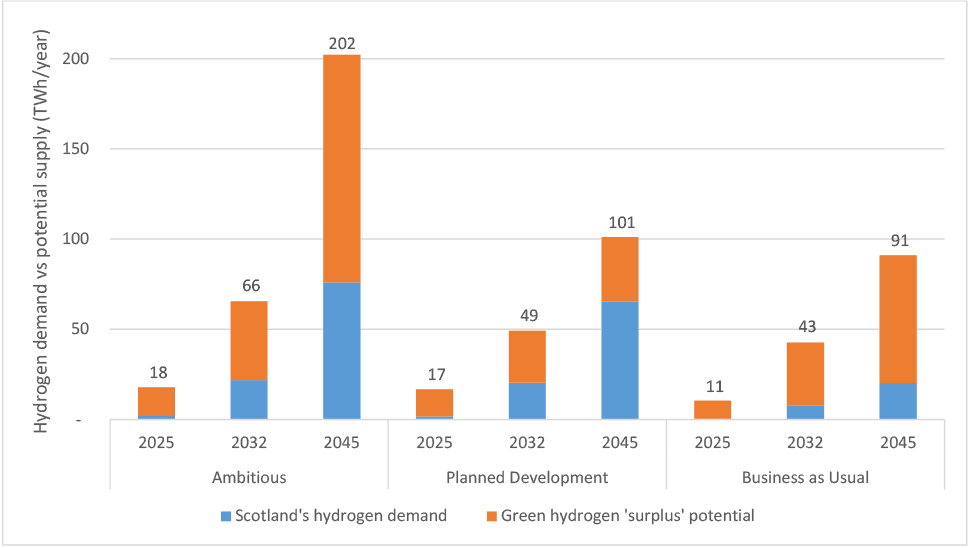
3.2.3 Scotland’s Net Green Hydrogen Export Projections
Previous hydrogen analyses within this report indicate that green hydrogen produced from Scotland’s offshore wind can exceed Scotland’s hydrogen demand. This is not an unexpected conclusion, since green hydrogen production requires renewable electricity for electrolysis, and Scotland is already a net exporter of renewable electricity. Considering Scotland’s future offshore wind deployment projections and its overall offshore wind resource, it is likely that Scotland’s clean energy export will keep increasing in the next decades.
Although it is likely that Scotland will continue to export renewable electricity generated from offshore wind to the rest of the UK, there are limitations related to electricity grid infrastructure between Scotland’s offshore wind resources and demand centres predominantly based in the south of the country. These substantial grid infrastructure requirements combined with the intermittency and non-dispatchability of offshore wind generation indicate that Scotland’s offshore wind resource can be fully harnessed only if other vector carriers are introduced, such as hydrogen.
This chapter does not aim to estimate the split between electricity export and green hydrogen export but rather indicate how much ‘surplus energy’ could be generated from offshore wind in Scotland and used for domestic (rest of the UK) or international (continental Europe) green hydrogen export. It should be highlighted that realistically, some of this ‘offshore wind energy surplus’ will be exported as electricity, rather than hydrogen only, particularly in 2020s before hydrogen export becomes more mature and cost competitive.
To understand the export opportunity associated with green hydrogen produced from offshore wind, Scotland’s hydrogen supply and demand projections had to be assessed independently. These projections were assessed in Section 2.2.3 (demand) and Section 3.2.2 (supply), and highlighted how much hydrogen will be required in Scotland between 2025 and 2045 (net-zero), and how much green hydrogen could be produced in the same period by harnessing renewable electricity coming from offshore wind generation.
Figure 3.2 compares Scotland’s potential hydrogen supply and demand in medium (2032) to long term (2045). It was assumed that although Scotland’s hydrogen demand in 2025 can be met from green hydrogen, the high costs and technology immaturity of transporting hydrogen over long distances will prevent Scotland to export hydrogen to the rest of the UK or internationally by 2025. There may be some specific cases where green hydrogen produced in Scotland may be transported to Northern England. However, the scale of this opportunity in 2025 is likely to be small, and the vast majority of ‘surplus’ offshore wind in Scotland will be used to feed into the local electricity grid rather than to produce green hydrogen for export.
The net green hydrogen export opportunity shown in Figure 3.2 was created using the best and the worst-case scenario from export perspective to understand what the opportunity range is. It was assumed that Scotland’s future annual net hydrogen demand needs to be met first, and any surplus green hydrogen can then be used for domestic or international export.
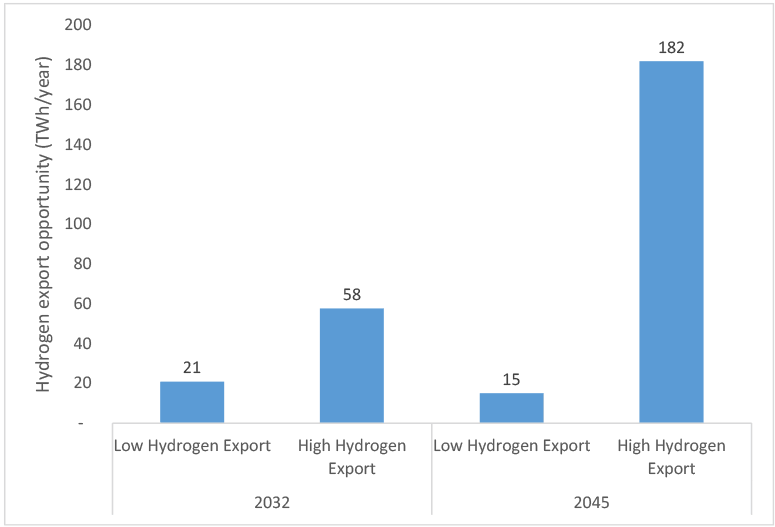
The Low Hydrogen Export scenario combined Scotland’s most conservative offshore wind generation projections, with the highest demand projections. This resulted in the lowest export opportunity for Scotland, since most of the green hydrogen produced from offshore wind would be used in Scotland, and less would be left for potential domestic or international export.
On the other hand, the High Hydrogen Export scenario assumed the most optimistic offshore wind deployment, and the lowest hydrogen demand uptake in Scotland. This resulted in significantly higher proportion of green hydrogen to be exported to the rest of the UK and continental Europe. The actual hydrogen export opportunity is likely to lie somewhere in between these two scenarios.
2032
The 2032 export scenarios revealed that Scotland’s offshore wind will have the capacity to meet Scotland’s entire hydrogen demand and export additional 21-58 TWh/year of hydrogen domestically (rest of the UK) or internationally (continental Europe). It should be highlighted that even in the most conservative export scenario with high hydrogen demand and low supply, Scotland’s offshore wind will be able to produce significantly more green hydrogen than will be required. This highlights the fact Scotland’s abundant offshore wind resources will be at the core of Scotland’s energy transition.
Scotland’s net hydrogen export opportunity in 2032 is projected to be between 21 and 58 TWh/year. Comparing the former with Scotland’s most optimistic hydrogen demand projections for 2032 shows that Scotland can produce at least twice as much hydrogen as it will be able to use by 2032. Based on the projections discussed in Section 2.2, the rest of the UK will require 42-60 TWh/year and the rest of EU 431-585 TWh/year. This indicates that there is likely to be sufficient hydrogen market by 2032 to uptake all of Scotland’s ‘surplus’ green hydrogen.
To conclude, Scotland’s offshore wind could produce 2-8x more hydrogen than it will require by 2032. Although a lot of this offshore wind generation will not be converted into hydrogen bur rather exported as electricity, the potential hydrogen export opportunity is evident.
2045
By 2045, Scotland will be able to produce enough green hydrogen not only to meet its hydrogen demand but also to export to the rest of the UK and continental Europe. The split of domestic versus international export was not assessed within this study. However, it will strongly depend on the cost of transporting this green hydrogen from A to B. Costs associated with hydrogen transport are assessed in Section 4.2.
Scotland will be able to export between 15 and 182 TWh of hydrogen annually. This strengthens the case for green hydrogen production from offshore wind in Scotland. Even when using the most conservative offshore wind deployment projections and the most ambitious hydrogen demand projections, Scotland can still produce more hydrogen than it will require by 2045.
Based on the projections discussed in Section 2.2, the rest of the UK will require 90-624 TWh/year and the rest of EU 668-1,551 TWh/year. This indicates that there is expected to be enough hydrogen demand for Scotland to become a major green hydrogen producer and exporter by 2045 by making the most of its offshore wind resources as well as its legacy of being a net energy exporter.
3.2.4 Summary
From this it can been seen that in all scenarios, it is likely that Scotland will, on a net basis, have potential to produce more hydrogen than can be consumed locally. It is acknowledged that this is an over-simplified picture and that other factors will affect the actual export potential including:
- Intermittency of offshore wind and resultant green hydrogen and the need to factor hydrogen storage and/or import into the overall system design. To ensure sufficient dispatchable hydrogen it is even possible that hydrogen import may at time be needed and be more cost effective than storage.
- The opportunity, at least in the medium term, for blue hydrogen to produce additional Scottish hydrogen and thereby increase the overall export opportunity.
- The likely continuance of some additional wind to directly generate electrical power into the UK electricity grid. Actual production of green hydrogen may therefore likely be lower than the theoretical production figures presented in this analysis.
Further study would be required to consider these factors in more detail. However, the overarching conclusion that Scotland likely has opportunity to be a net exporter of hydrogen is considered valid.
3.3 Scotland’s Existing Infrastructure
The extensive physical infrastructure existing principally due to Scotland’s well-established oil and gas sector presents several opportunities to facilitate in particular the export of hydrogen either to Europe or worldwide.
In this section we make a preliminary assessment of pipelines, ports and terminals that could be repurposed for green hydrogen export. Offshore oil platforms could also potentially be repurposed for offshore green hydrogen production but as these would be specific to individual wind farm developments they have not been considered in detail in this initial study.
This section also presents a high-level overview of the potential modes of ship-based export of hydrogen, including via conversion to ammonia or Liquid Organic Hydrogen Carrier (LOHC)
3.3.1 Pipeline Infrastructure
Figure 3.3 shows the existing Scottish oil and gas pipeline and terminal infrastructure, overlaying the existing offshore wind farms and currently planned (ScotWind Leasing round) further development areas.
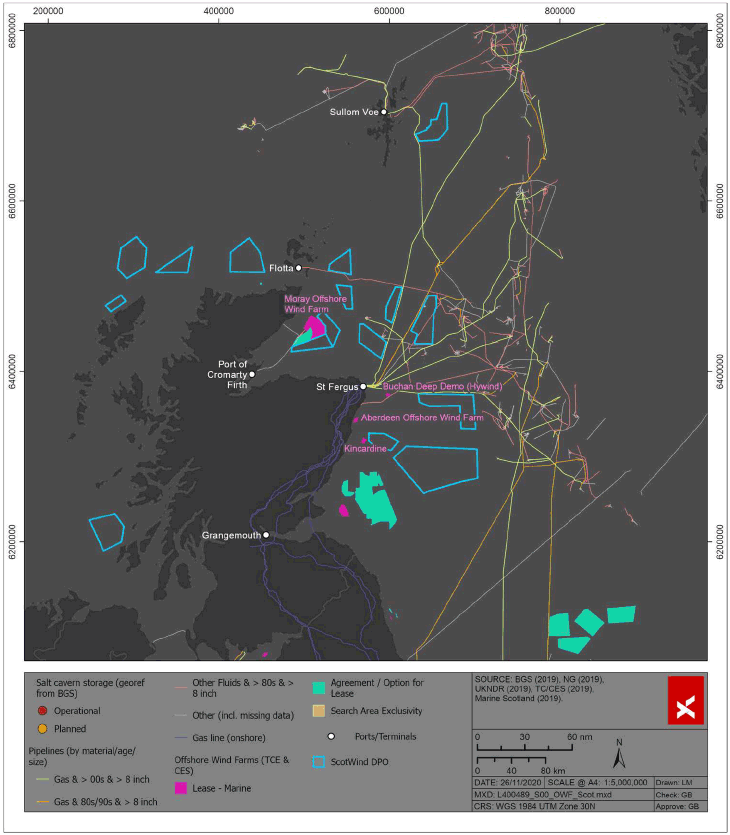
Figure 3.4 shows the extension of this infrastructure to England and to continental Europe via interconnector pipelines at Bacton.
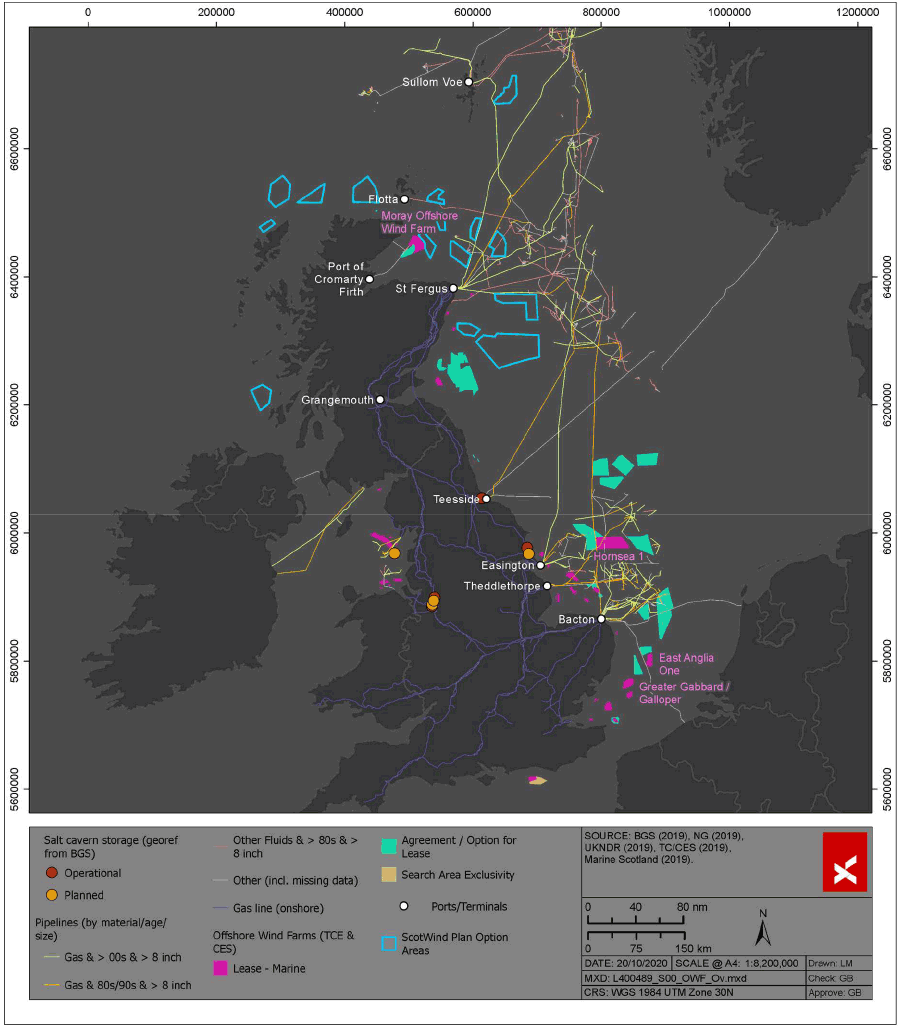
There are currently four pipelines, which run from the European continent to the British mainland:
- The UK-Belgium interconnector (IUK): This pipeline runs between Bacton in Norfolk and Zeebrugge in Belgium and connects Britain to the mainland Europe gas network. This pipeline has an import capacity of 25.5 billion cubic metres (bcm) a year. It is the only pipeline that currently operates bi-directionally, meaning it can both import gas to Britain as well as export gas to mainland Europe. The direction of flow depends on supply and demand and relative prices.
- The UK – Netherlands pipeline (BBL): This runs from Balgzand to Bacton in Norfolk. This pipeline has an import capacity of 14.2 bcm a year.
- The Vesterled pipeline link: This pipeline connects St Fergus in Scotland to a number of Norwegian gas fields. This pipeline has a capacity of 14.2bcm a year.
- The Langeled pipeline: At the time of its commissioning in 2006 this pipeline, which runs from Nyhamna in Norway to Easington in Yorkshire, became the longest underwater gas pipeline in the world at 1,200km. The pipeline has a capacity of 26.3 bcm
In terms of exporting hydrogen to the northern European demand hubs highlighted in Section 2, Scotland therefore has opportunity to export both via England and via Norway. Export via Bacton potentially brings synergy with export of blue and green hydrogen produced from the southern North Sea gas fields and offshore wind farms. Scottish hydrogen could potentially be transported to Bacton via the existing 34” SEAL (Shearwater to Bacton) pipeline, which in turn could be connected to St. Fergus through repurposing of (and reversing flow in) the 20” Fulmar to St. Fergus gas pipeline.
Hydrogen introduced into the Langeled pipeline to Easington could potentially be redirected to Bacton via relatively short new interconnections between gas pipelines currently running from southern gas fields to both terminals. This could also serve as an export route for hydrogen produced from the Humber Net Zero hub. Similarly, repurposing of the existing CATS gas pipeline into Teesside could have synergies with hydrogen produced from that planned industrial decarbonisation hub.
It is beyond the scope of this initial study to examine in detail these multitude potential opportunities for pipeline repurposing. It is clear however, that they need to be considered in the context of an integrated UK-wide (or indeed European) hydrogen transportation plan, as also highlighted in the recent ORE Catapult report.
Xodus has previously performed a study for the Oil & Gas Technology Centre (OGTC) considering the repurposing of UK oil and gas pipelines for both hydrogen and CO2 transport, including examining some of the technical consideration associated with such a change of service. The conclusions of that study are summarised as follows:
- Oil and gas pipelines have been converted to hydrogen service before, and the conversion of subsea pipelines is possible if the pipeline meets the material and dimensional requirements for safe operation. Not all pipelines will meet these requirements or will be too damaged for safe operation. Novel technologies such as polymer liners have been explored to make unsuitable lines compatible to hydrogen service. Installation of polymer liners on subsea pipelines for hydrogen service is technically challenging and requires additional research to establish technical and economic feasibility.
- Hydrogen service causes embrittlement of materials: a reduction in yield strength and fracture toughness and an increased crack growth rate, leading to reduced fatigue life.
- Hydrogen embrittlement is dependent on operating conditions and material properties and has a greater effect on steels with higher tensile strength.
- The recommended pipeline material grades for hydrogen service are API X42 and X52. Grades above X52 are more likely to be severely affected by hydrogen embrittlement.
- The hydrogen maximum operating pressure should be defined so that the maximum stress in the pipeline walls is below 30-50% of the minimum specified yield strength.
- The limitations of stress and material grade equates to approximately 50 – 150bar maximum pressures for typical sizes of X52 pipelines which appears feasible for hydrogen storage and transportation at this stage.
- Detailed data on material specifications or operating pressures and temperatures of subsea oil and gas pipelines is not readily available. It is however more likely for older pipelines to be of a lower material grade (X42 or X52). Pipelines from the ‘90s were identified as optimum as they are likely to still have acceptable mechanical integrity and old enough to have a lower yield strength.
- For pipelines that are considered incompatible with hydrogen service due to material compatibility, novel technologies could be developed to overcome material challenges. Polymer liners are currently installed in subsea pipeline, though it is already technically challenging to retrofit them on existing pipelines. Significant advancements in liner technology would be required to ensure compatibility with hydrogen service. Currently no liner can prevent permeation of hydrogen, due to its small atomic size, and therefore a liner will not prevent hydrogen embrittlement. A suitably designed venting system would also likely be required to avoid gas build up in the annulus between the liner and the steel, that would cause liner collapse in case of depressurisation.
Beyond (or possibly to interconnect) existing pipeline infrastructure, it will be possible to build new hydrogen pipelines to export hydrogen from Scotland.
Currently there are circa 4,500km of hydrogen pipelines worldwide, operators are mainly large industrial gas producers such as Air Liquide, Air Products and Chemicals, Praxair, etc. Pipe sizes typically between 8-in & 12-in with design pressures typically in the range 40 to 60 bar (Oil&GasStatistics, 2020).
Pipelines are typically made of carbon steel (API 5L or ASTM-specified grades). There are approximately 40 km of hydrogen pipelines within the UK and 1500 km across mainland Europe. However, these pipelines are primarily for distribution purposes as oppose larger transmission pipelines such as those in the US.
To transport hydrogen gas through a newly installed pipeline system the same considerations discussed in the previous section regarding material selection apply. The manufacturers and installation companies needed are exactly the same as those already supplying and installing natural gas pipelines and infrastructure.
Other potential solutions include using fibre reinforced polymer (FRP) pipelines for hydrogen distribution. Xodus is aware of one FRP pipe manufacturer, which has successfully qualified one of their pipe grades for hydrogen service.
Whilst the far offshore of Scotland is heavily congested with existing pipelines, Figure 3.5 (source : NPD) shows that south of St. Fergus there is a very low density of existing pipelines (other than the interconnector lines already mentioned above) , which would enable a relatively unencumbered route towards northern continental Europe.
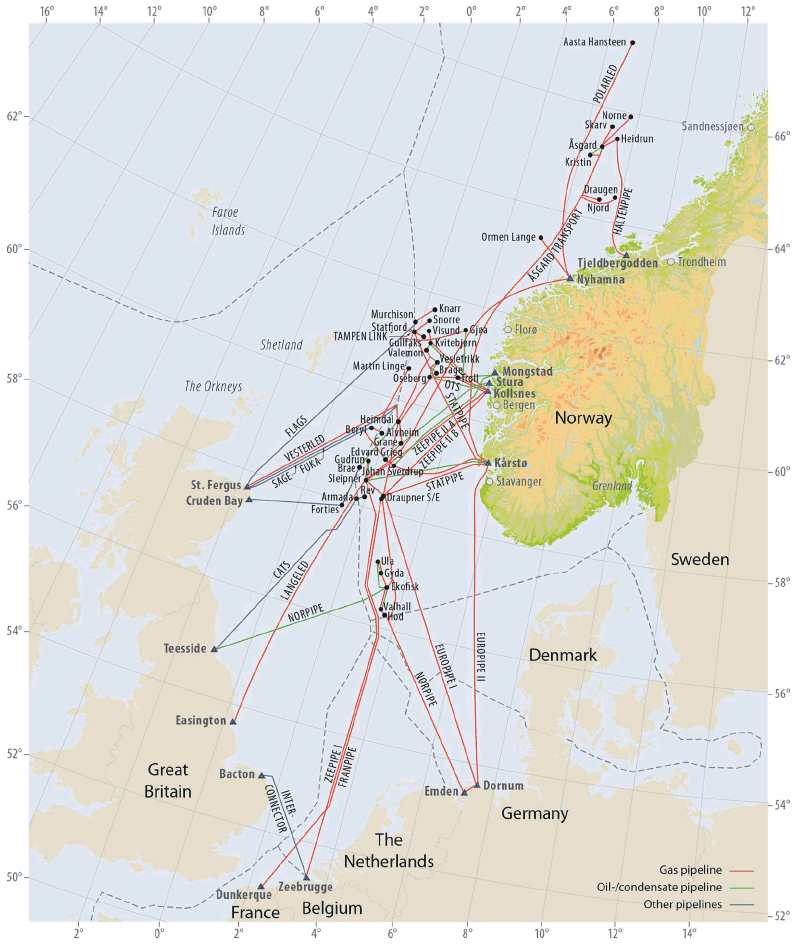
More significant constraint is likely encountered landing new pipelines in northern Europe. The tidal mudflats along much of the coastline from northern Netherlands to Denmark, which collectively form the Wadden Sea, are inscribed as a UNESCO World Heritage Site and contain several Ramsar protected areas, is indicated in Figure 3.6.
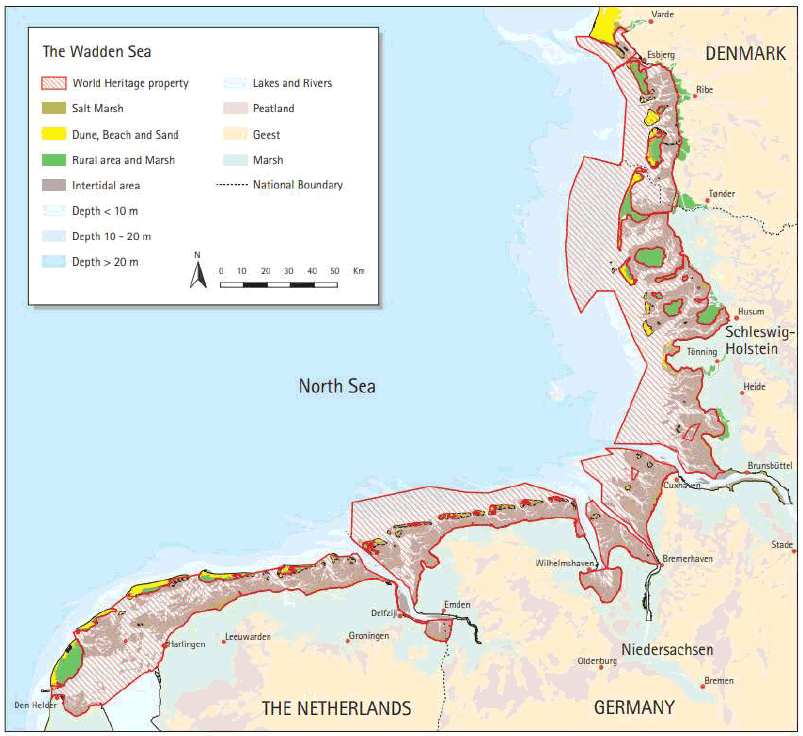
This will constrain potential landing points, other than possibly if following existing corridors into Emden or Dornum and will perhaps most likely drive the landing point south to Den Helder. Here though, a dense infrastructure of Dutch offshore gas platforms and pipeline is encountered, similar to that on the UK side of the Southern North Sea. More work would be needed to identify feasible and consentable new pipeline routes from Scotland to northern Europe.
With a single supply directly to mainline Europe would give rise to the issue of security of supply, linking within a regional network offshore and on land within Europe may avoid this and increases the number of tie-in locations within the hubs.
In summary, Scotland has both multiple potential opportunities to export hydrogen to the rest of the UK and to Europe via repurposed oil and gas pipelines. There is good corridor for a new pipeline direct to Europe, but constraints on landing point would need careful consideration.
3.3.2 Ship-Based Hydrogen Export
Scotland has a number of major oil terminals and ports that could be redeveloped for the ship-based export of hydrogen. However, the majority of hydrogen used worldwide today is produced near to the point of consumption, which means that hydrogen is not commonly a globally transported commodity. Therefore, before considering specific terminals and ports, it is useful to introduce the four principal technologies currently proposed for such export, as features of these technologies will be important when considering the potential attractiveness of an existing site.
3.3.2.1 Liquified Hydrogen
Whilst natural gas is commonly transported in liquefied form (LNG), this is less feasible for hydrogen due to the far lower boiling point of hydrogen; where natural gas typically liquifies at -160 deg.C, hydrogen requires -253 deg.C which is only 20 deg.C above absolute zero. This introduces exotic material and cryogenic risk issues and results in high cooling energy demand. Therefore, historically liquified hydrogen has only been used in niche and small-scale applications.
A notable development in relation to bulk ship transportation of liquified hydrogen is the Hydrogen Energy Supply Chain (HESC) pilot project to ship hydrogen from Australia to Japan (HESC, 2020). The newly built 116m long Suiso Frontier Liquified Hydrogen Carrier ship, built by Kawasaki Heavy Industries, contains 1,250 m3 of cryogenic storage.
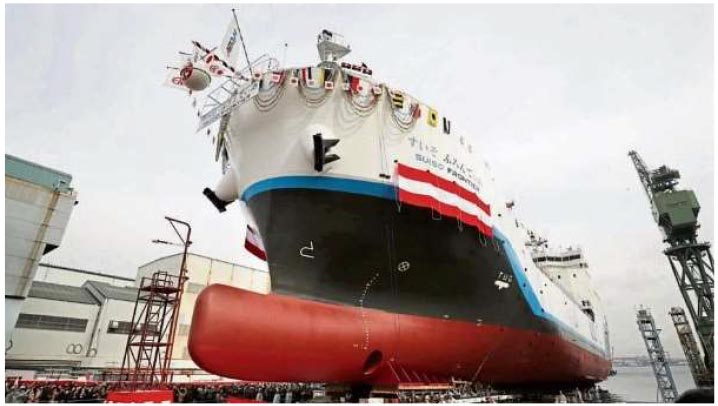
3.3.2.2 Ammonia
Ammonia is easier to transport than hydrogen or LNG as it can be turned into liquid at temperatures of -33°C or a pressure above 10 bar. This is a very similar pressure/temperature range to LPG and the same vessels are commonly used. Ammonia shipping is already a very well-established global operation.
Vessel capacity spans a wide range from small carriers generally utilising pressurisation rather than refrigeration, through to Very Large Gas Carriers (VLGC). Larger vessels use refrigeration or semi-refrigeration for storage. Typical vessel capacities and dimensions are shown in Table 3.4, and Figure 3.8 shows a typical VLGC.
| Carrier Type | Type | NH3 or LPG Volumetric Capacity (k m3) | Length (m) | Beam (m) | Draft (m) |
|---|---|---|---|---|---|
| Very Large Gas Carrier (VLGC) | Refrigerated | 60 – 100 | 230 - 300 | 35 - 40 | 12 |
| Large Gas Carrier (LGC) | Refrigerated | 40 – 60 | 200 | 32 | 12 |
| Mid Gas Carrier (MGC) | Refrigerated | 25 – 40 | |||
| Handysize Gas Carrier | Semi Refrigerated | 15 – 25 | |||
| Small Gas Carrier | Semi-Refrigerated | 5 – 15 | 100 | 25 | 12 |
| Small Gas Carrier | Pressurised | < 5 |
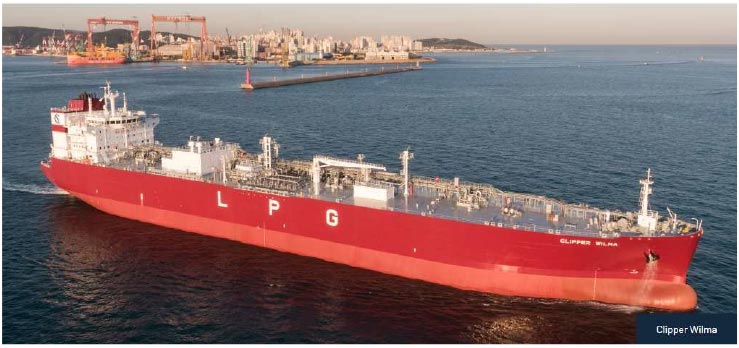
Ammonia is conventionally produced from natural gas via the integration of steam methane reforming (to produce hydrogen) and the Haber-Bosch process to catalytically combine hydrogen with nitrogen separated from air. Globally, this process is currently used to produce 150 million te of ammonia per year, mostly for use as fertiliser. Without carbon capture and storage (CCS), it is estimated that the Haber-Bosch process is responsible for about 1.2% of all man-made carbon emissions.
However, for ammonia production from green hydrogen, a far simplified process is required, as illustrated in Figure 3.9. The air separation and core Haber-Bosch reactor are retained, but the stream reforming and methanation stages are removed. In a greenfield context, the whole system lends itself to electrification.
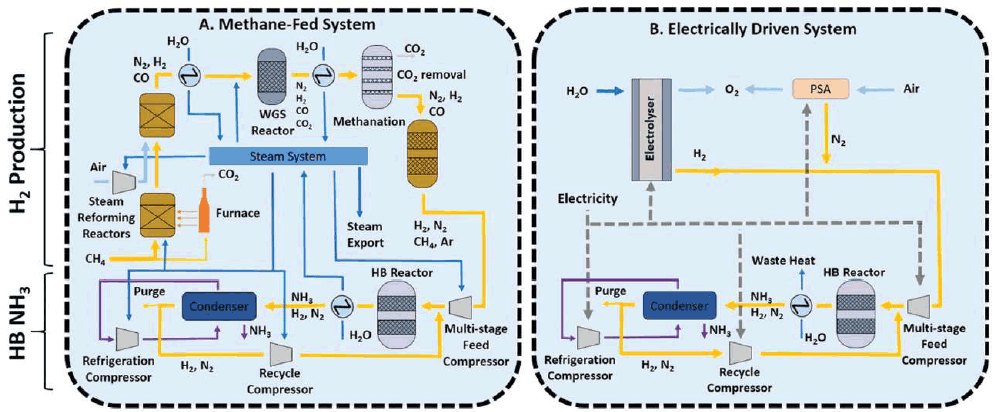
A key difference between ammonia and LOHC (see Section 3.3.2.3) is that ammonia can (and most likely will) be used directly, either as fertiliser feedstock or as direct fuel. Indeed, there are today no known industrial scale processes to decompose (‘crack’) ammonia back to hydrogen. A recent study (Ecuity, 2020) has assessed various potential technologies and it has been estimated by the UK Committee on Climate Change that the energy loss turning ammonia back into hydrogen would be around 15 – 25 % (Committee on Climate Change, 2018).
3.3.2.3 Liquid Organic Hydrogen Carriers (LOHC)
Just as ammonia improves the transportability of hydrogen by combining it chemically with nitrogen to make a compound which is liquid a higher temperature, so LOHC refers generally to the chemically combining of hydrogen (‘hydrogenation’) with a carrier organic compound for transportation, and then chemically decomposing (“de-hydrogenation”) to regenerate hydrogen and the original carrier compound, which is then shipped back for re-use. A basic premise of LOHC is that the hydrogenated product is a liquid at ambient temperature, this enabling the use of conventional bulk liquid tanker (rather than the refrigerated or pressurised carriers used for ammonia)
Many different chemicals are currently under active consideration for LOHC, including:
- Methyl Cyclohexane (MCH). Chiyoda Corporation have developed and successfully demonstrated the SPERA Hydrogen® system using MCH (hydrogenated form of toluene) (Chiyoda Corporation, 2017). In May 2020, a pilot plant generating 50m3/h MCH successfully commenced supply of hydrogen transported by sea from Brunei Darussalam by sea to Japan. This may be considered the currently most advanced LOHC process.
- Di-benzyltoluene
- N-ethylcarbazole
- Di-cyclohexylmethane (DCHM)
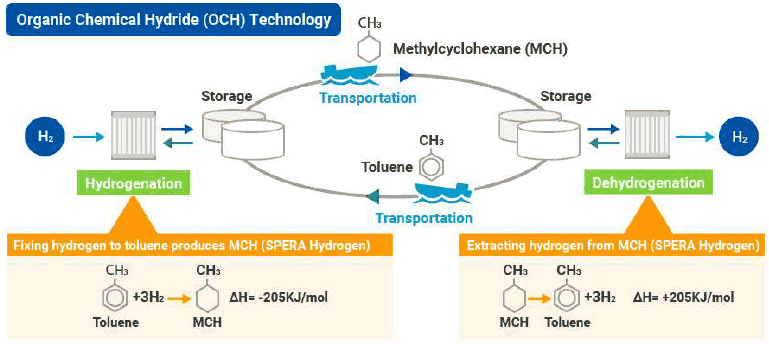
In all cases the hydrogenation step is highly exothermic (giving out heat) and the de-hydrogenation step highly endothermic (requiring heat). LOHC could provide a safe and lighter weight option for hydrogen transportation. As the technology is relatively new, several factors will need to be explored before these can be viable options. The LOHC must have a high recovery yield of both hydrogen and the carrier and the carrier must be robust enough to endure multiple cycling.
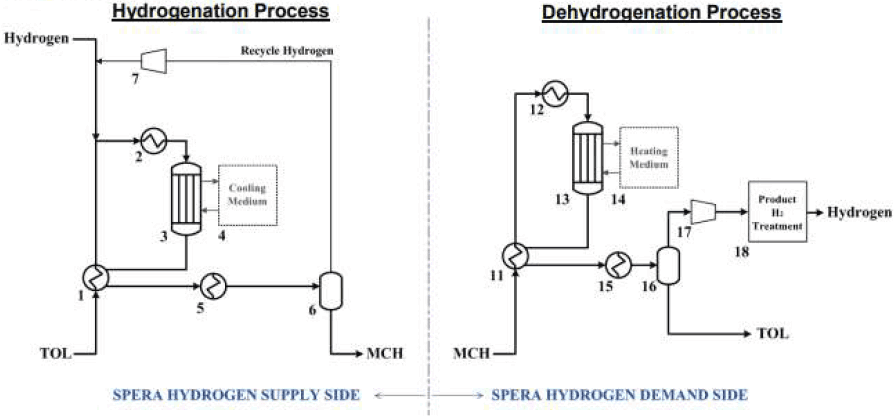
3.3.2.4 Compressed Hydrogen
Ship transportation by compression alone (rather than liquefaction) has not generally been proposed for hydrogen due to the ultra-high pressures required or relatively low energy storage density achieved at conventional pressures proposed for the compressed transportation of natural gas (CNG). However, and for completeness, it is noted that Global Energy Ventures (GEV) have announced plans to develop a compressed hydrogen ship (H2 Ship) capable of carrying up to 2,000 te of hydrogen, targeted at the Australian market (GEV, 2020).
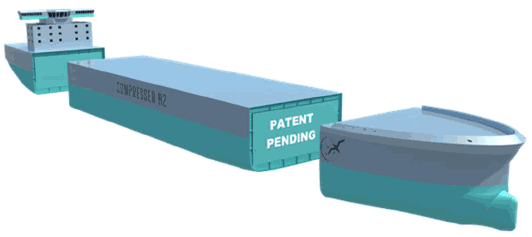
Comparative analysis of these four technologies is beyond the scope of this study, though the following broad observations may be made:
- Shipping of ammonia is already well proven whereas liquified/compressed hydrogen, LOHC technologies are currently immature. Saudi Arabia and Japan are moving forward with plans for transportation of green hydrogen via ammonia.
- Whilst inherently simpler than chemical conversion, both liquified and compressed hydrogen concepts are likely to encounter significant cryogenic risk and metallurgical challenges.
- Conversion of hydrogen to an LOHC (or ammonia) and back to hydrogen consumes additional energy which reduces the overall energy efficiency from wind turbine to consumer.
- Due to the requirement for regeneration and return, LOHC is only suitable for fixed point to point applications (such as the SPERA trial), rather than as a means for distribution of hydrogen. A relatively high cycling frequency is also likely to be needed to amortise the cost of LOH production and regeneration and therefore LOH is not well suited to long distance transportation
For the purposes of cost modelling in Section 4, only ammonia has been considered as there are well established cost benchmarks both for ammonia production and shipping, albeit cost of ammonia production without integration with SMR is less well established.
3.3.3 Terminals and Ports
Scotland possesses multiple existing oil and gas terminals and ports that could be repurposed for hydrogen export. As illustrated in the previous section, all technologies for hydrogen export will require some degree of pre-treatment of hydrogen; in the case of ammonia and LOHC this pre-treatment for chemical conversion is significant. Hence, so long as suitably located, existing industrial sites with similar processes may have an inherent advantage over greenfield sites. Evolution to include hydrogen export may also extend the economic lifetime of existing hydrocarbon terminals. This opportunity has already been recognised by several terminals and various studies have been initiated, as is acknowledged in the following sections.
3.3.3.1 Sullom Voe
The Sullom Voe terminal on Shetland is the most northerly of Scottish terminals and has been in operation since 1978. Fed from oil fields both east and west of Shetland, it is anticipated to remain in hydrocarbon production through to 2045 (and beyond).
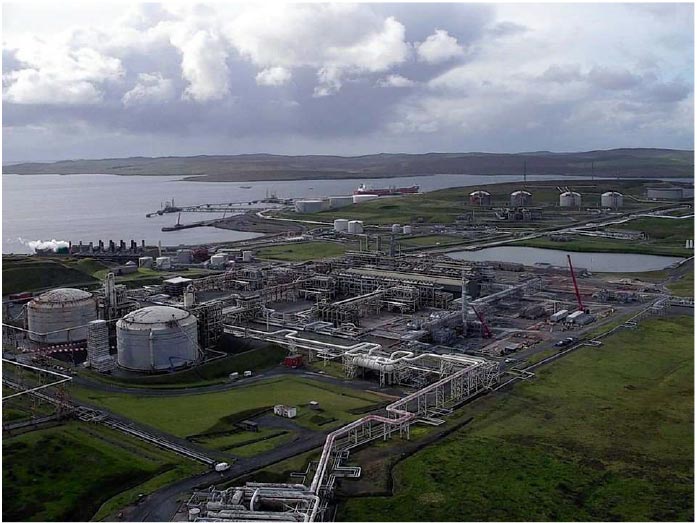
A consortium, including Shetlands Islands Council (SIC), the OGTC and with representatives from regional major offshore oil companies, has recently initiated the ORION Project which envisages the wholescale transformation of Sullom Voe, to include electrification of offshore oil production and generation of both blue (with carbon sequestered in depleted East of Shetland oil fields) and green hydrogen. With limited mainland grid interconnection (Ofgem approval has only recently been granted for a 600 MW interconnector), green hydrogen production and export is a potential key enabler for either future regional offshore wind development or the estimated up to 1 GW of onshore wind potential on Shetland.
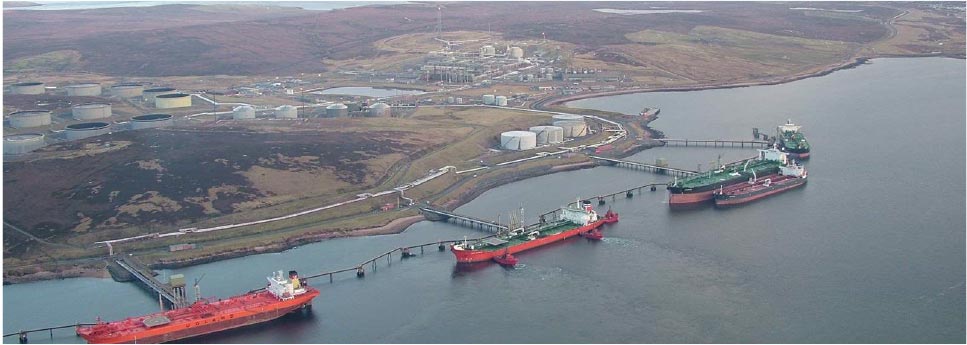
Sullom Voe has four existing tanker loading jetties; three are designed for crude oil export in tankers up to 350 DWT. The fourth is designed for oil and LPG export in tankers up to 80,000 m3 (mid-range VLGC). The similarity between LPG and NH3 export suggests the fourth jetty would also be suitable for ammonia export. The clear area around the terminal likely easily sufficient to accommodate any enlarged safety zoning and separation distances required for the production and handling of hydrogen and ammonia.
Sullom Voe is uniquely well-positioned to enable the development of the most extreme northerly of Scotland’s offshore wind resources which might otherwise be stranded if reliant on mainland grid connection. Whilst relatively isolated from existing UK hydrocarbon pipeline network, it is close to existing Norwegian pipeline infrastructure which may provide alternative hydrogen export routes towards northern Europe. The extensive terminal could also be used for direct refuelling of hydrogen-powered ships.
3.3.3.2 Flotta
The Flotta Terminal is located on the island of Flotta in the Orkney Islands just north of mainland Scotland. It was commissioned in 1977, with Repsol Sinopec Resources UK Limited becoming the major shareholder and operator in May 2000. The terminal covers a 395-acre site, approximately one sixth of the area of Flotta Island.
Crude oil is imported to the Flotta Oil Terminal from several offshore installations in the Flotta Catchment Area through a 210km 30” subsea pipeline.
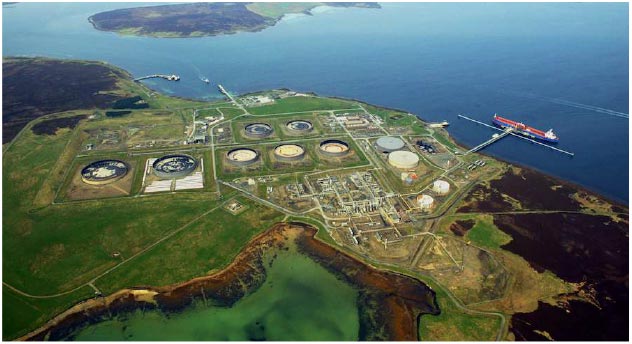
The Terminal includes a 'T' shaped jetty capable of handling either crude oil or LPG, situated on the north coast of Flotta. The minimum depth of water alongside is 20.12m and vessels of up to 170,000 tonnes DWT can be handled there.
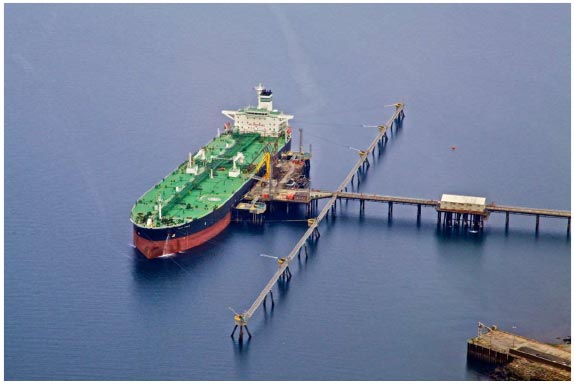
Similar to Shetland, Orkney has recently obtained approval for a 220 MW interconnector to the Scottish mainland, also largely premised on enabling future offshore wind generation. Production and export of green hydrogen from Orkney would similarly diversify and potentially enable further offshore wind development.
Similar too to Sullom Voe, the Flotta Terminal:
- is located remotely, making it well able to accommodate any increased safety separation distances.
- Potentially able to provide a refuelling location for hydrogen-powered shipping.
Flotta is the proposed location of the Hydrogen Hub Orkney (H2O) test facility which forms part of the Hydrogen Offshore Project (HOP), Conducted as part of the BEIS Hydrogen Supply Programme, and with project partners comprising Aquatera, Cranfield University, Doosan Babcock, European Marine Energy Centre (EMEC), National Oilwell Varco (NOV) and The Oil and Gas Technology Centre (OGTC), the HOP project explores various opportunities for offshore hydrogen production by re-using existing oil & gas
infrastructure.
3.3.3.3 Port of Cromarty Firth
Continuing south, the Port of Cromarty Firth is already a major staging post for the Scottish offshore wind industry, building on a long history of construction and service provision for the offshore oil and gas sector.
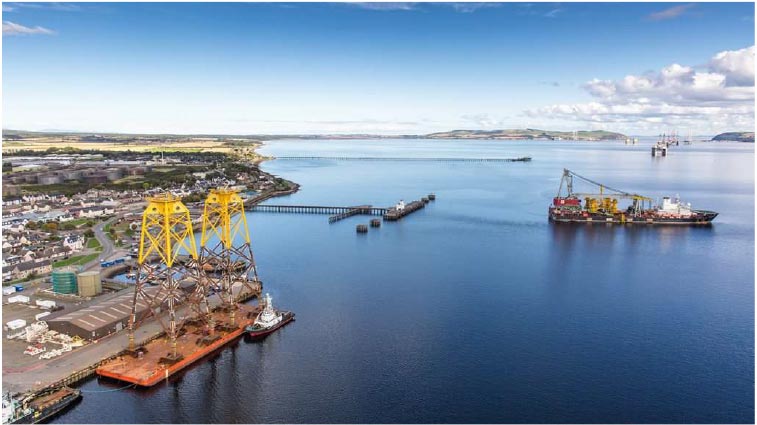
With support from HIE, the Highland Council and OGTC the consortium Opportunity Cromarty Firth has been formed specifically to advance plans for green hydrogen production, use and export (including LOH and liquefaction) and with the ambition to become a Free Trade Zone (Opportunity Cromarty Firth, 2020).
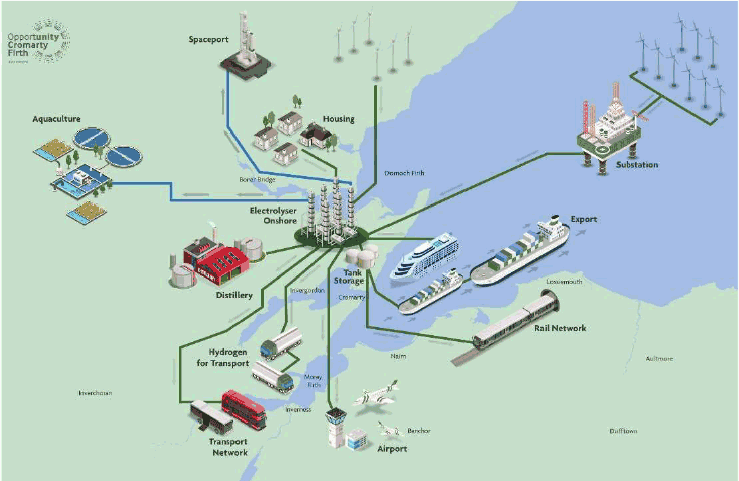
The Port of Cromarty Firth is home to 6 key marine facilities, including the Nigg Energy Park and Oil Terminal. Combined, these facilities provide over 2,000m of quayside in water depth up to 14m and sheltered anchorage in up to 30m water depth.
The Port of Cromarty Firth is well positioned for the multiple North East ScotWind option areas
3.3.3.4 Outer Hebrides Hydrogen Hub
Similar to Orkney, the Outer Hebrides have been developing a green hydrogen strategy and trialling green hydrogen production and use, including the H2seed and H2growth projects, since 2010. In 2019 the Outer Hebrides Local Energy Hub (OHLEH) included green hydrogen generated from a power-from-waste project. The Comhairle nan Eilean Siar (CnES) is currently planning further green hydrogen expansion as part of its updated Energy Strategy.
Stornoway Port and the associated BiFab facilities at Anish Point provide over 600m of quayside, though being in a water depth of only 6m would currently make them unsuitable for LPG/NH3 gas carrier vessels. The current Stornoway Port Masterplan includes the development of a 400m quayside, 10m depth deep-water port adjacent to Anish Point, as shown in Figure 3.19.
Stornoway is well placed for the northerly ScotWind option areas.
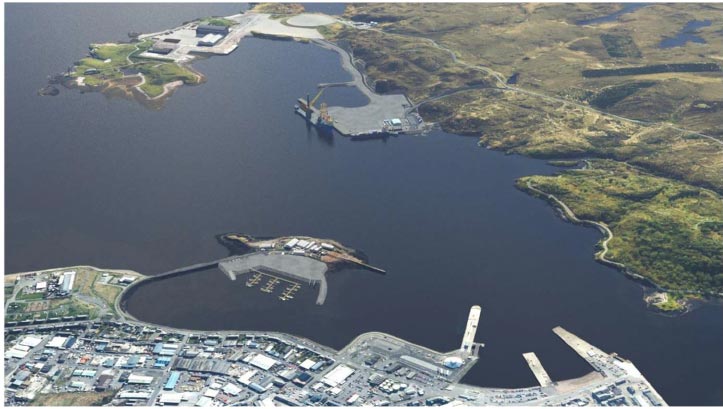
3.3.3.5 St. Fergus Gas Terminal
The St. Fergus Gas Terminal approximately 65 km north of Aberdeen was opened in October 1982 and remains the central gathering hub for Northern North Sea gas production. The plant receives gas through the SEGAL (Shell Esso Gas and Associated Liquids) system. This includes wet gas transported through the FLAGS (Far North Liquids and Associated Gas System) pipeline and from the Central North Sea through the Fulmar Gas Pipeline. It also receives gas from Norway through the Tampen pipeline, which connects the Norwegian gas transport system to the FLAGS system.
St. Fergus is thus potentially optimally positioned to receive hydrogen generated offshore and transported to shore through existing gas pipelines. It is also likely the primary candidate for any new hydrogen export pipeline to Europe.
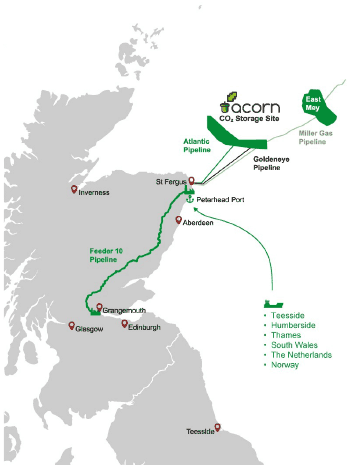
St. Fergus is the focus of the Acorn CCS project, being developed by Pale Blu Dot Energy (Acorn, 2020). Whilst initially targeting capture and storage of CO2 emissions from the St. Fergus Gas Terminal, the project then plans to produce blue hydrogen from gas landed at St. Fergus. Hydrogen produced from Acorn is envisaged to supply a domestic market, as part of the “Hydrogen Coast” initiative. No export of hydrogen is currently planned from Acorn; the nearby port at Peterhead is envisaged only to receive CO2 imports from elsewhere.
St. Fergus lacks any deepwater port of its own. Peterhead port is a key oil and gas supply base (including decommissioning). Whilst theoretically capable of receiving ships up to 280m in length (and therefore all but the largest VLGC), the extensive other port activities and close vicinity of nearby Peterhead town do not obviously commend Peterhead for hydrogen (or ammonia/LOHC) production and export, certainly in comparison with the previously discussed sites.
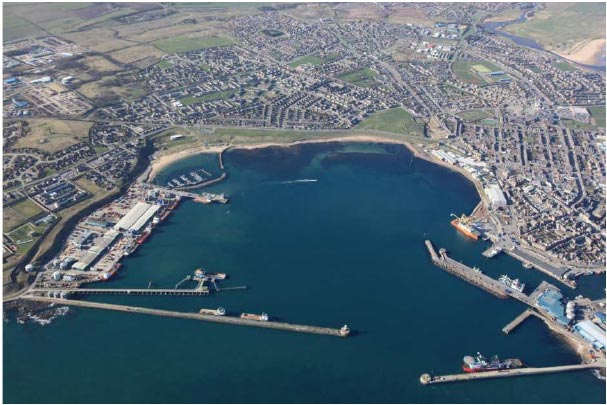
3.3.3.6 Grangemouth/Hound Point
With its extensive existing petrochemicals manufacturing capability, the Petroineos-operated Grangemouth refinery is potentially best suited of all the considered sites for production of ammonia or LOHC. The plant exports oil via the Hound Point marine terminal, which initial appears also suitable for loading of VLGC.
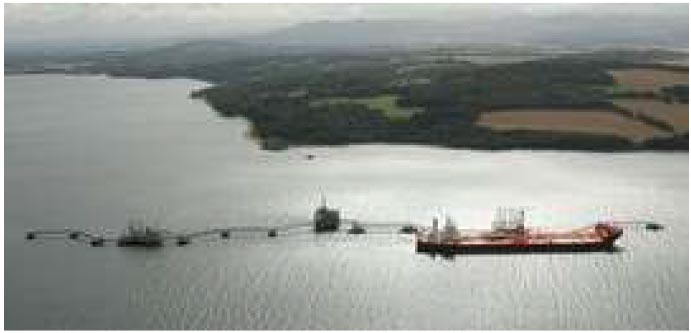
Petroineos’ published “Grangemouth Renaissance” plan (INEOS, 2020) contains no mention of potential hydrogen export, though most recently a subsidiary of Singapore’s LNG9 company has announced plans for a blue hydrogen and CCS project (seemingly similar to Acorn) in the vicinity of Grangemouth (The Falkirk Herald, 2020).
3.3.3.7 Other Sites
The sites listed above are considered to likely represent the most promising candidates for export of Scottish green hydrogen. Other sites, though not excluded, may suffer from several disadvantages, including:
- Size. Many small ports will lack the minimum quayside depth or LOA to accommodate the size of hydrogen/ammonia carrier required for commercial export operation. These smaller ports are perhaps also likely to be close to built-up areas and have busy commercial operations, potentially leading to increased safety issues.
- Location. Ports such a Hunterston and Greenock on the west coast of Scotland are distant from the wind resource and poorly positioned for European export.
3.3.4 Subsurface Hydrogen Storage
The primary scope of this study is the upstream production of green hydrogen from offshore wind, rather than its downstream storage and use. However, storage of hydrogen will clearly be an important component of the integrated green hydrogen system, especially to compensate for intermittency of production, and it is pertinent to briefly consider Scotland’s potential ability to store hydrogen in geologic formations.
In 2013 the EU-funded HyUnder project assessed geological storage of hydrogen in:
- Salt caverns
- Depleted oil and gas fields
- Aquifers
- Conventionally mined rock caverns
Salt caverns are the only currently proven form of geological hydrogen storage, with several sites operational in the US and UK (Teesside). Salt caverns are also used for short-term storage of natural gas.
Unfortunately, and as shown in Figure 3.23, Scotland lacks any onshore salt deposits. However, there is extensive Permian deposit offshore in the areas covered by existing oil and gas platform and pipeline infrastructure, and by future planned offshore wind developments. Thus, opportunities may exist to provide offshore hydrogen storage in salt caverns.
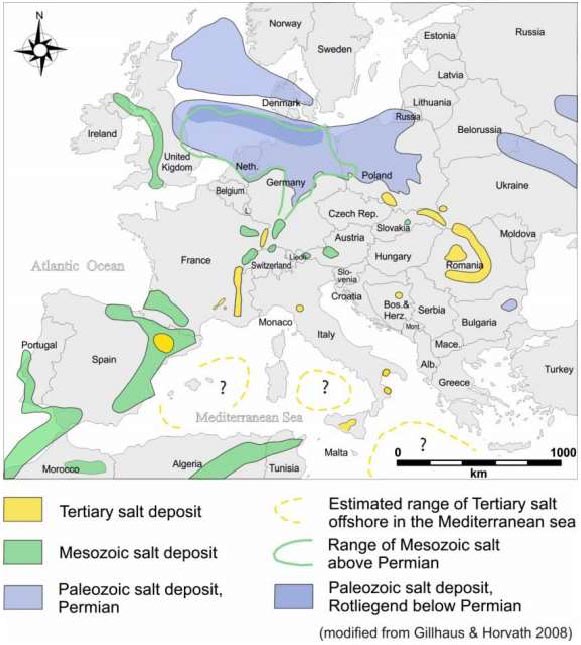
Clearly, Scotland also has huge potential for hydrogen storage in depleted hydrocarbon reservoirs. These reservoirs are well understood from decades of operation and are accessed by existing well, platform and pipeline infrastructure. However, there are a number of fundamental challenges associated with using depleted reservoirs for hydrogen storage, including:
- Hydrogen has a higher diffusivity in pure water than methane. Also, it has a lower viscosity and a lower density than methane. Because the chemical and physical properties of hydrogen are different to those of methane (CH4), the main component of natural gas, the effects of hydrogen on the reservoir rock and cap rock need careful consideration.
- Due to these differences, there are potential risks involved such as; (i) the conversion of hydrogen to CH4 and H2S due to microbial activity, (ii) chemical reaction of hydrogen with the minerals of the reservoir rock/cap rock and thus potential resulting porosity changes, and (iii) the loss of aqueous H2 by diffusion through the cap rock.
- Presence of residual hydrocarbons which will mix with stored hydrogen and, depending on end use, may then require separation from extracted hydrogen.
Current research recommends choosing depleted gas fields for hydrogen storage where the residual gas has low CO2 concentrations. The mineralogical composition of the reservoir rocks should contain low amounts of sulphate and carbonate bearing minerals. Research has also focused on developing modelling applications to incorporate the chemical and mechanical effects between the rock material and the working fluids.
The HyStorPor research project, led by the University of Edinburgh, is currently at the forefront of research in these areas (University of Edinburgh, 2020).
3.3.5 Summary
Scotland has a range of existing infrastructure from the oil and gas industry that could be repurposed to develop a hydrogen economy. This includes:
- An extensive infrastructure of existing O&G pipelines, much of which overlays the 2020 Offshore Wind Plan Option areas in the Sectoral Marine Plan and includes four pipelines that currently connect the UK to continently Europe. Examples of repurposing exist but key challenges include long term integrity of now-aging pipelines, especially for the additional challenges of transporting hydrogen, and a potentially extended period between cessation of hydrocarbon production and repurposing for hydrogen transport.
- Several Scottish ports and terminals are well-equipped for hydrogen export and are already actively considering repurposing for hydrogen export. Each port has some compelling advantages:
- Sullom Voe and Flotta have existing terminal and export infrastructure and are likely to have a vital role in developing the sizeable northerly Scottish offshore wind resource that might otherwise be stranded from mainland connection.
- Port of Cromarty Firth is well placed for the largest number of ScotWind DPOs and has existing terminal infrastructure and a well-established supply chain. Opportunity Cromarty Firth is well developed and supported.
- St. Fergus presents an opportunity to build on the ‘first mover’ advantage presented by the Acorn project, though is likely to primarily present a domestic, rather than export, opportunity due to the limitations of Peterhead port. St. Fergus may also provide the most sensible starting point for any hydrogen export pipeline given its nodal location within the current gas pipeline infrastructure.
- With its existing petrochemical manufacture, Grangemouth is likely best positioned to generate ammonia or LOHC for export.
- Depleted fields and other subsurface structures that would allow for large scale storage of hydrogen. Research in this area however is still in its infancy.
Several individual regional initiatives are already underway, including in Shetland and Cromarty Firth. However, there appears to currently be no overall national strategy or plan and therefore a risk that these initiatives compete rather than collaborate. There may, for example, be merit in multiple sites generating hydrogen but combining export (especially if ammonia or LOHC).
A co-ordinated strategy and plan for hydrogen transportation both within the UK and to Europe is required in order to maximise the efficient re-use of this existing infrastructure and to ensure optimum redevelopment of terminals and ports.
3.4 Supply Chain Database
3.4.1 Approach
3.4.1.1 Overview
A Scottish green hydrogen supply chain database was developed to capture the national supply chain capability and identify Scottish-based companies that are already operating, or planning to operate, within the green hydrogen sector.
The creation of this database followed a similar procedure to that which Xodus employed during the creation of the Scottish offshore wind supply chain database (Scottish Industry Directories, 2020). The process included engagement with hydrogen sector stakeholders to identify Scotland-based companies with relevant interest and capability to support the development, construction and operation of a green hydrogen project using electricity from a wind farm. The hydrogen sector stakeholders contacted as part of this approach were:
- Aberdeen City Council
- Aberdeen Renewable Energy Group
- Argyll and the Islands Council
- Bright Green Hydrogen
- British Compressed Gasses Association
- Decom North Sea
- Deepwind Cluster
- Doosan Babcock
- European Marine Energy Centre
- Energy Technology Partnership
- Forth & Tay Offshore Cluster
- Grangemouth Refinery
- Highland Council
- Highlands and Islands Enterprise
- North East CCUS (NECCUS)
- Oil and Gas Authority
- Oil and Gas Technology Centre
- Oil and Gas UK
- Opportunity North East (ONE)
- Offshore Renewable Energy Catapult
- Opportunity for Renewables Integration with Offshore Networks (ORION) Project
- Orkney Islands Council
- Port of Cromarty Firth
- RenewableUK
- Scottish Enterprise
- Scottish Renewables
- Scottish Gas Networks (SGN)
- Shetland Islands Council
- Scottish Hydrogen & Fuel Cell Association (SHFCA)
- St Fergus Gas Terminal
- Stornoway Port Authority
- Subsea UK
- Western Isles Council
Engagement with stakeholders resulted in the generation of a long list of over 1000 companies from both specific stakeholder suggestions and compilation of stakeholder membership lists. Identified companies were then contacted via direct email and/or through supply chain membership organisations and invited to complete an online survey of their supply capability. The online survey portal was open for 4 weeks to allow interested companies sufficient time to participate. The survey asked suppliers to provide information relevant to this study, including data that could be shared publicly as part of a potential future online Scottish hydrogen industry directory. The information requested as part of the survey included:
- Company Name
- Registration number
- Address
- Website
- Local Authority
- Capability description
- Experience in the hydrogen sector
- Experience supplying parallel sectors
- Categories in which they have current supply capability, or future supply interest
The approach resulted in 118 survey submissions from organisations with an interest in supplying the Scottish hydrogen sector. Analysis of the database of responses was undertaken to generate a view of Scotland’s supply chain capabilities. The database was also used to identify the key links between the green hydrogen sector and other relevant parallel industries to assess the wider potential supply chain capability not captured through a database approach.
3.4.1.2 Supply Chain Taxonomy
The key to creating a supply chain database that can be inclusive of potential future suppliers to the sector was to adopt a taxonomy that appropriately covers the breadth and depth of the industry. This allowed for the requirements in each supply chain area to be well defined as well as for overlapping capabilities with supply chains serving parallel sectors to be considered.
A taxonomy was developed that focused on the upstream (generation) to midstream (transport) of the hydrogen supply chain. This classification system was designed to clearly define the various stages of the hydrogen supply chain in broad enough terms that companies – particularly those that have the capacity to participate but have not historically done so - could identify where they could be of service. It was also designed to identify and classify the multitude of products and services required for the development, construction, and operation of a green hydrogen project using electricity from a wind farm.
Five ‘Primary’ stages of the hydrogen supply chain were identified, with an additional sixth category for ‘Sector Support Services’ created to capture those companies whose services would not be supplied directly to a hydrogen project but would still support the growth and development of the wider hydrogen sector. These were then broken down into 36 Secondary categories, the specifics of which were further categorised into 142 Tertiary categories. These are given in Table 3.5.
| Primary category | Secondary category | Tertiary category |
|---|---|---|
| Development of Hydrogen Infrastructure | Concept Engineering and Consultancy | Feasibility and pre-concept design studies |
| Onshore environmental studies and surveys | ||
| Offshore environmental studies and surveys | ||
| Engineering, Procurement, and Construction (EPC) | Fixed Offshore Structures | |
| Floating Offshore Structures | ||
| Pipelines | ||
| Process plant design | ||
| Onshore Facilities - Civils and buildings | ||
| Specialist hydrogen shipping design | Specialist hydrogen and/or similar shipping design | |
| Marinisation design services | Marinisation design services | |
| Detailed Component Design | Electrolyser design | |
| Post-processing equipment design | ||
| Storage equipment design | ||
| Pipeline design - onshore | ||
| Pipeline design - offshore | ||
| Electrical system design and modelling | ||
| Control and safety system design | ||
| Metering design | ||
| Manufacture of Hydrogen Infrastructure | Marinisation of equipment | Marinisation of equipment |
| Electrolysers | Supply of fully assembled electrolysers | |
| Flow plates - cathode and anode | ||
| Membrane electrode assembly | ||
| Gaskets - anode, mid-cell and cathode | ||
| Housing - anode and cathode | ||
| Valves | ||
| Indicators | ||
| Sensors - pressure and temperature | ||
| Control systems and monitoring | ||
| Outlet manifolds - water and oxygen | ||
| Cooling water systems | ||
| Plate heat exchangers | ||
| ATEX extraction fans | ||
| Water treatment system (demineralisation) | ||
| Hydrogen purification system | ||
| Desalination plants | Supply of fully assembled desalination plants | |
| Reverse osmosis membranes | ||
| Pressure vessels | ||
| Brine seals | ||
| Valves | ||
| Filters | ||
| Housing | ||
| Compressors | Supply of fully assembled compressors | |
| Main body steelwork | ||
| Valves | ||
| Gearbox, pistons, driveshafts, other internal steelwork | ||
| Gauges, sensors & indicators | ||
| Motors | ||
| Electronics & control panel | ||
| Gaskets & fastenings | ||
| Buffer tanks & connecting piping | ||
| Steel frame | ||
| Liquefiers & post-processing | Cooling systems | |
| Filters | ||
| Reactors | ||
| Heat exchangers | ||
| Condensers | ||
| Evaporators | ||
| Separators | ||
| Circulators | ||
| Expanders / Companders | ||
| Blowers | ||
| Adsorbers | ||
| Subcomponents for post-processing machinery | ||
| Tube trailers and storage tanks | Vessels | |
| Valves | ||
| Filling and extraction components | ||
| Level probes | ||
| Suspensions | ||
| Heat exchangers and heaters | ||
| Offshore Structures | Jackets | |
| Topsides | ||
| Risers | ||
| Piles | ||
| Pipelines | Pipeline | |
| Coating | ||
| Anodes | ||
| Flanges bolts and gaskets | ||
| Valves | ||
| Sensors - flowmeters, pressure, temperature | ||
| Electrical system | Heating, Ventilation and Air Conditioning systems | |
| Switchgear | ||
| Subsea cables | ||
| Sensors and metering | ||
| Control and monitoring systems | ||
| Communication systems | ||
| Health & safety and communications networks | Fire & Gas, ESD and Control Systems | |
| IT Networks, Offshore comms | ||
| Bespoke manufacturing services | Precision machining | |
| 3D printing | ||
| Installation and commissioning of hydrogen infrastructure | Hydrogen production plant installation | Hydrogen production plant installation |
| Commissioning | ||
| Offshore Structures installation | Jackets | |
| Topsides | ||
| Piling | ||
| Anchoring | ||
| Site survey | ||
| Pipeline lay | ||
| Pipeline trenching / backfilling | ||
| Offshore cable installation | Offshore cable installation | |
| Pipeline installation | Landfall | |
| Riser | ||
| ROV / diver | ||
| Pipeline-handling equipment | ||
| Pressure testing | ||
| Commissioning | ||
| Ports installation | Installation port infrastructure | |
| Heavy lifting port services | ||
| Onshore works | Onshore civils | |
| Onshore logistics | ||
| Operation, maintenance and decommissioning of hydrogen infrastructure | Training | Training |
| Ports infrastructure to support offshore O&M | O&M port infrastructure | |
| Hydrogen handling port services | ||
| Onshore logistics | O&M coordination | |
| Transport of hydrogen logistics - road transport | ||
| Offshore logistics | Transport of hydrogen logistics - export overseas by subsea pipelines | |
| Transport of hydrogen logistics - export overseas by shipping | ||
| Crew Transfer vessels | ||
| Health and safety | Health and safety inspections | |
| Health and safety equipment | ||
| Hydrogen plant maintenance and service | Electrolyser inspection, repair, refurbishment and replacement | |
| Inspection and repair of post-production processing plants | ||
| Inspection and repair of storage and delivery components | ||
| Balance of plant maintenance and service | Desalination plant inspection and repair | |
| Offshore substructure inspection and repair | ||
| Pipeline inspection and repair | ||
| Electrical equipment inspection and repair | ||
| Valve inspection, repair and maintenance | ||
| Tooling and consumables | ||
| Operations and maintenance support and IT support | Software and IT support | |
| Offshore decommissioning services | Offshore decommissioning services | |
| Onshore decommissioning services | Onshore decommissioning services | |
| Transport of Hydrogen | Road transport delivery | Trucks |
| Rail | ||
| Shipping delivery | Tankers | |
| Other seagoing vessels to carry hydrogen | ||
| Sector Support Functions | Professional services | Consultancy |
| Trade associations and bodies | ||
| Health & safety | ||
| R&D and education | Non-academic research & technology organisations | |
| Universities (including institutes) | ||
| Further education college | ||
| Other public and private organisations |
3.4.2 Survey Results
3.4.2.1 Overview of Survey Respondents
The hydrogen supply chain survey received 118 responses, both from companies currently operating in Scotland and those with future ambitions to operate in Scotland.
Prior to processing and analysis, the raw data was cleaned to remove duplicates and responses from companies whose current and future supply is not suitable for the hydrogen supply chain. This resulted in a total of 109 unique responses from companies suitable for consideration in this study. These responses were further assessed for whether a company’s stated supply chain capability or ambition was consistent with the company’s own description of their current operations, with inconsistent responses removed. For instance, if a company stated they manufactured jacket structures while their capability statement and company profile showed they were primarily involved in the structural design process, then their response was edited to reflect this.
As well as being asked to indicate which areas of the supply chain they can, or aim to, participate in companies were asked to indicate in which Scottish Local Authority areas they are based. The number of companies active in each local authority area is indicated in Figure 3.24. As only one address could be supplied per company, it is possible that each company also operates or provides some services from an alternative location from their given address. Where companies supply multiple areas, further work is required to determine exactly which products or services are provided from which location.
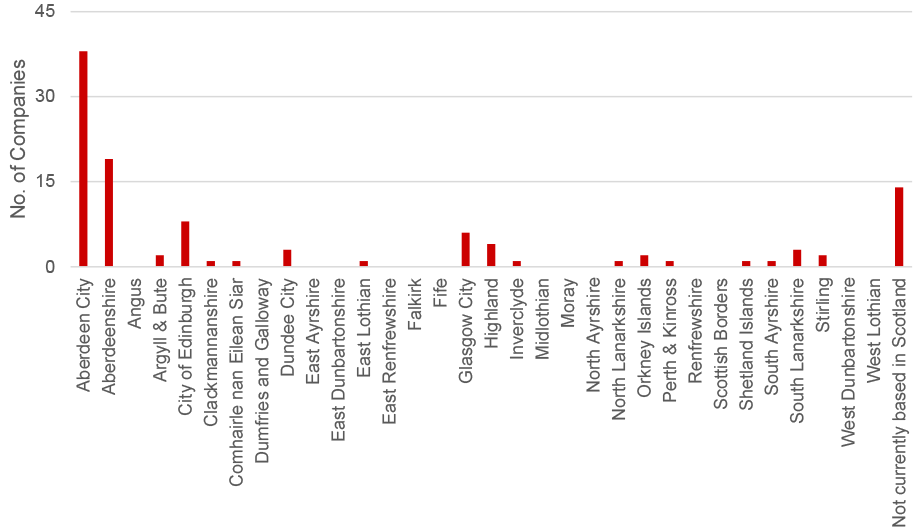
As can be seen in Figure 3.24, the majority of respondents (52%) are from North-East Scotland, particularly Aberdeen City and Aberdeenshire. Other clusters can be found in major population centres, such as Edinburgh (7% of respondents), Glasgow (6% of respondents), and Dundee (3% of respondents).
Approximately 13% of respondents are not currently based in Scotland. Of the 14 non-Scottish companies that responded, five were based in the rest of the UK (four in England and one in Northern Ireland), four were based in Norway, two in the USA, and one each in France, Germany, and Spain.
Respondents were also asked to rank their current involvement in the hydrogen supply chain, from ‘No Involvement’ to ‘Somewhat Involved’ and ‘Highly Involved’. As this is a subjective selection made based on each company’s perception of the market and their standing in it, these participation rankings were largely left unedited. The few exceptions to this were when a company’s stated capability and/or ambition did not align with their stated level of involvement. A breakdown of company level of involvement in the hydrogen supply chain by Scottish Local Authority area is shown in Figure 3.25 (noting that Local Authority areas with no responses have been omitted from the figure for clarity).
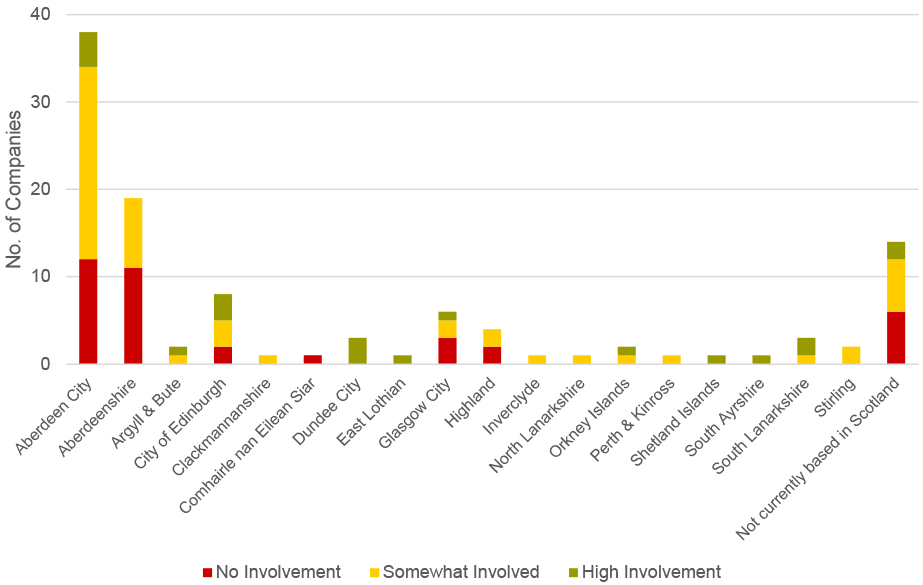
Most companies perceived themselves to be ‘Somewhat Involved’ or ‘Highly Involved’ with the Scottish hydrogen sector. Companies that responded to the survey but are not actively involved in the hydrogen sector were most likely to be based in the major cities: Aberdeen, Edinburgh, and Glasgow. Companies outside these areas (Aberdeenshire being the exception) tended only to respond if they were already somewhat or highly involved in the hydrogen sector.
As companies were asked to self-assess their level of involvement in the hydrogen supply chain, the response is highly subjective and seems to vary quite considerably. Some companies that offer only one product/service deem themselves to be highly involved, whereas others who offer many deem themselves to only be somewhat involved or not involved at all. While there is not a strict pattern, it seems that companies have broadly determined their level of involvement according to how tailored their product is for the hydrogen sector. For instance, a higher proportion of companies offering supply of fully assembled electrolysers see themselves as being highly involved in the hydrogen sector than companies whose services apply to numerous sectors (e.g. offshore decommissioning), which has a higher proportion of companies expressing lower levels of involvement. The more specialised to hydrogen a company’s service offering is, the more likely they are to perceive themselves to be highly involved in the sector.
Companies were also asked to indicate in which other sectors they are active and have expertise. This is shown in Figure 3.26. The sectors chosen to align with the Scottish Industry Directories, plus the addition of Oil and Gas which has no specific Scottish Industry Directory but has clear synergies with the hydrogen sector. Note that companies were able to select as many options as they deemed relevant and have been counted within each service offering.
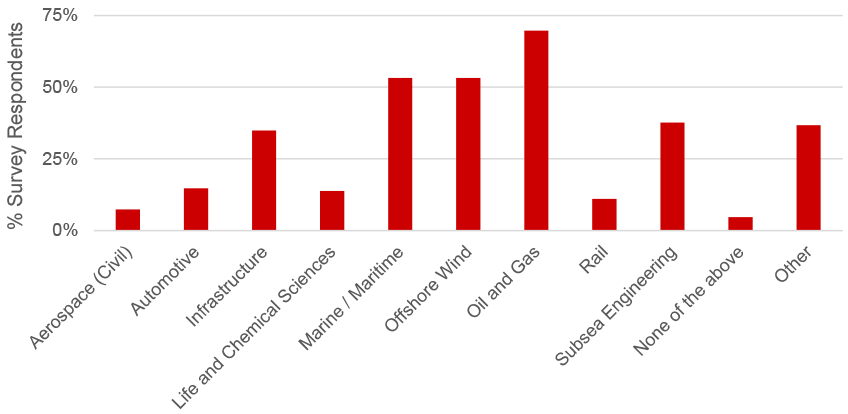
The main sector in which respondents have existing experience is Oil and Gas, followed by Marine / Maritime, Offshore Wind, and Subsea Engineering. Most companies were active across multiple experience areas, further suggesting that the knowledge and skills required in these sectors are broadly aligned and transferable and that we might expect significant overlap between their supply chains.
Many of the companies that selected the ‘Other’ option have expertise in forms of renewable energy other than offshore wind, including onshore wind and solar. Very few companies selected ‘None of the above’, but most of those that did outlined their activities in the ‘Other’ category and are active in areas of renewable energy outwith offshore wind.
The distribution of experience shown in Figure 3.26 aligns with the data shown in Figure 3.25; Aberdeenshire and Aberdeen are well established hubs for the oil and gas, offshore wind, marine / maritime, and subsea engineering sectors. The fact that many of these companies have assessed themselves to be involved to some degree in the hydrogen sector suggests that there is significant overlap between the supply chains of these industries and hydrogen. As a result, many such companies could be expected to have transferable skills and expertise that could be leveraged to meet the needs of the hydrogen sector.
3.4.2.2 Primary Level Overview of Hydrogen Supply Chain
As indicated in the taxonomy shown in Table 3.5, companies were asked to indicate which products and services (specified in the Tertiary categories) they could provide within six Primary stages of the hydrogen supply chain. The breakdown of the percentage of respondents offering services in each of the six Primary stages is shown in Figure 3.27. No distinction has been made between whether a company either has current supply capability or has an ambition for future supply in this area. Figure 3.27 shows the percentage of companies active in each Primary stage of the supply chain and not the extent to which they are active within this i.e. if a company has indicated activity in each of the secondary or tertiary categories of any of the primary stages then they are counted equally to a company that has selected only one such category in that stage.
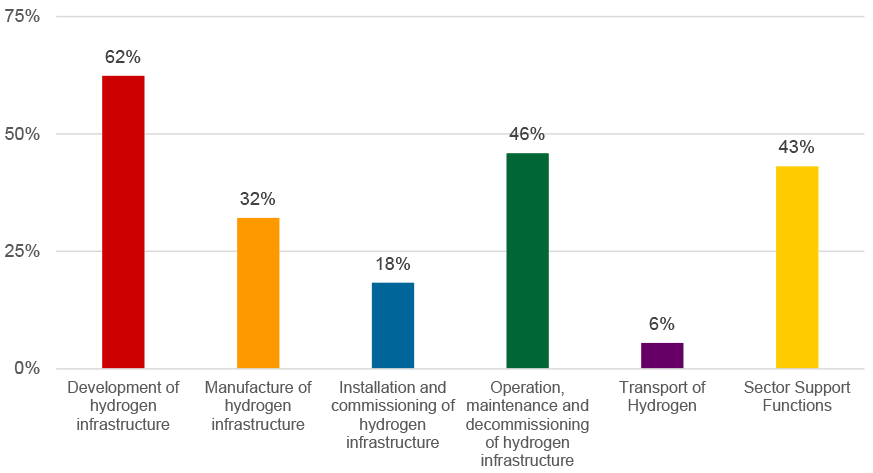
The majority of respondents offer services in the development of hydrogen infrastructure i.e. in design and concept engineering services. Slightly under half of respondents offer services in O&M and decommissioning of hydrogen, and slightly fewer offer sector support functions. As many of these services are desk-based roles, this correlates with the data shown in Figure 3.24 where most respondents were based in Scotland’s major cities. Approximately one third of respondents offer Manufacturing services. The number of companies offering Installation services is lower, and Transport services lower still. This is to be expected given that the hydrogen sector is still in the early stages of development and so there have not been many projects for companies to participate in providing manufacturing and installation services. Very few companies offer transport of hydrogen services.
Most companies were active or expressed interest in numerous stages of the supply chain. Very few companies were only active in a single supply chain stage:
- 8 companies were only active in development
- 5 companies were only active in manufacturing
- 0 companies were only active in installation and commissioning
- 4 companies were only active in operations, maintenance, and decommissioning
- 0 companies were only active in transport
- 15 companies were only active in sector support functions (most of whom offered consultancy services but not design)
Companies offering services in the development stage (mostly related to design) were most likely to also offer services in another stage of the supply chain, particularly operations and sector support services (predominantly consultancy).
Figure 3.28 shows how the number of companies active across each Primary stage of the hydrogen supply chain varies according to the industries in which they have experience. Note that double counting is to be expected as companies were able to be active in numerous stages of the supply chain as well as across numerous industries.
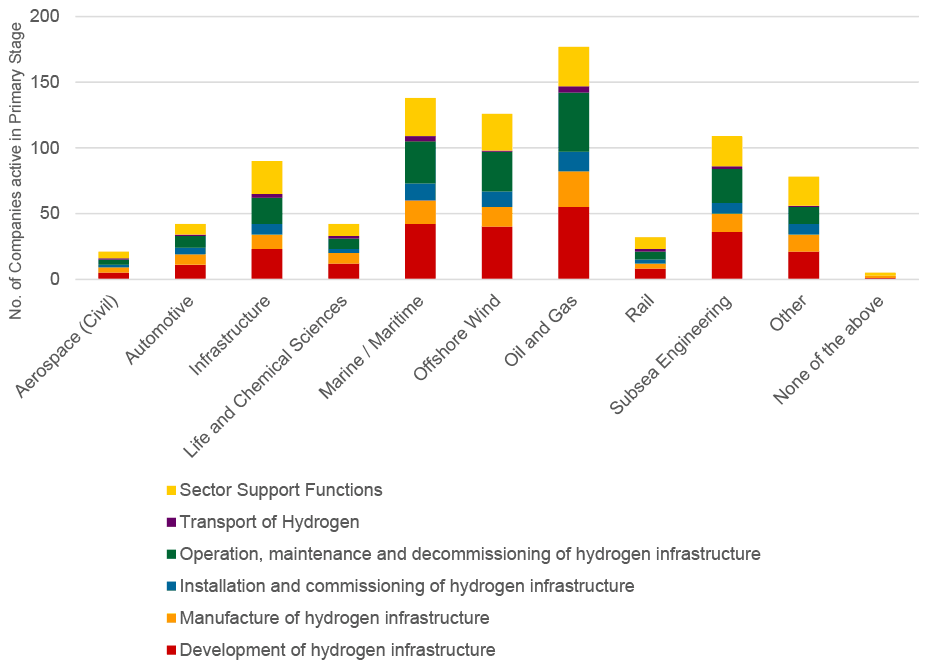
Within each experience sector, the proportion of companies active in each Primary stage of the hydrogen supply chain remains fairly consistent; the sectors in which companies have experience does not significantly affect the stages of the hydrogen supply chain in which they participate. This suggests that none of the Primary stages of the hydrogen supply chain are being predominantly served by parallel supply chains in any one of the other experience sectors. Rather, the experience sectors are likely to share many aspects of their supply chains, which would also be suitable for providing products and services to the hydrogen industry.
3.4.2.3 Secondary Level Overview of Hydrogen Supply Chain
The 6 Primary stages of the hydrogen supply chain are broken down into 36 more detailed categories as shown in the Taxonomy in Table 3.5. Note that these are categories of products and services offered by companies and not the products and services themselves. Figure 3.29 shows the number of companies that can or are aiming to offer services in each Secondary category. This provides a clearer idea of the capabilities that each survey respondent either has or aims to have within the hydrogen supply chain, as well as highlighting areas that may currently be underserviced and would provide an opportunity for new entrants to the market.
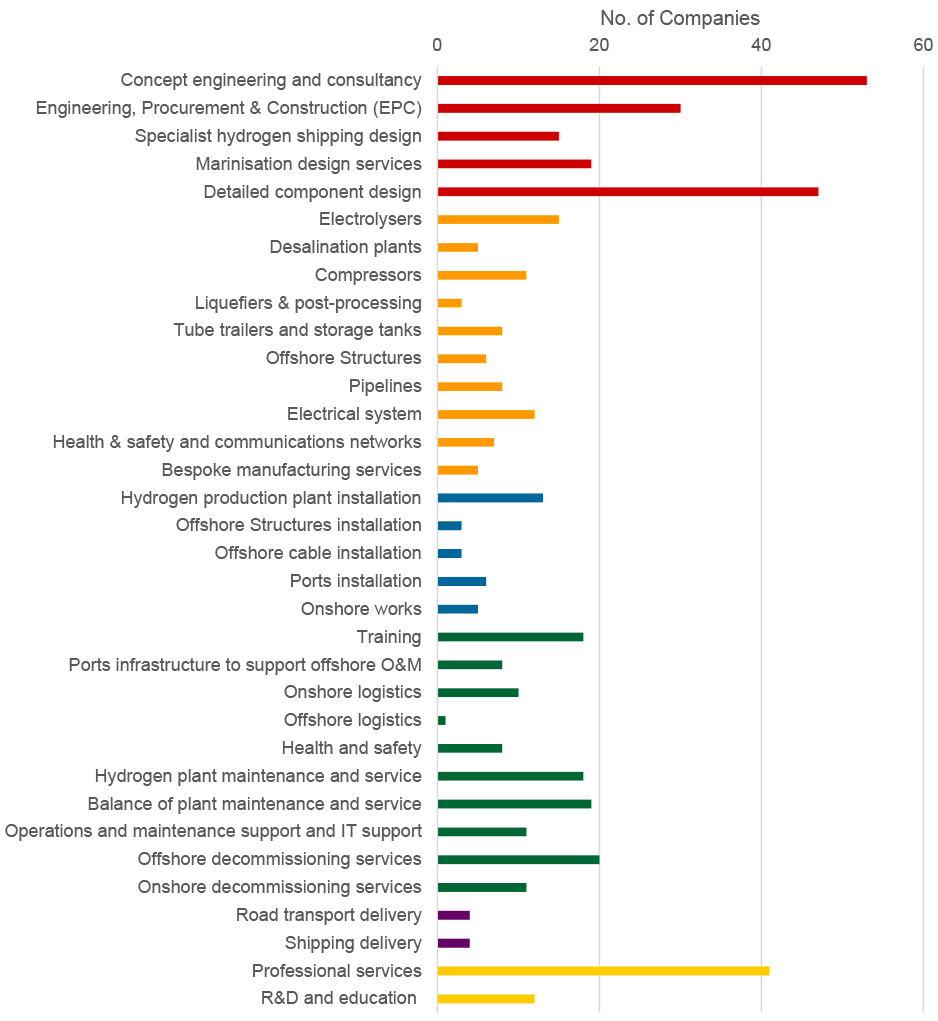
Figure 3.29 shows that there are a high number of companies involved in the development of hydrogen infrastructure, particularly in engineering and design. Almost half of the survey respondents have indicated that they have capability or would be interested in providing such services. Significantly fewer companies have indicated such an interest in participating in the Construction stages (Manufacturing and Installation) of the hydrogen supply chain. However, this could be reflective of the nascent state of the Scottish hydrogen sector. With so few projects currently in development, there is a lack of opportunity for companies to participate in manufacture and installation of hydrogen infrastructure. It is expected that as the sector matures, and more projects are developed, greater interest will be shown in participating and building capability in these stages of the supply chain.
Fewer than one in five survey respondents indicated capability or ambition to provide O&M and Decommissioning services. This is surprisingly low given parallels between this stage and broader Health & Safety supply chains used by similar sectors (e.g. oil and gas, offshore wind, subsea engineering, etc.). This could indicate that the quantity of survey responses was too low to provide a comprehensive overview of Scottish capabilities or could suggest that companies do not currently perceive that their sectors overlap with the needs of the hydrogen supply chain. If the latter, then early engagement with suitable companies to identify areas of overlap and inform them of opportunities to engage would be appropriate.
The supply chain stage with the fewest number of companies participating is Transport. It appears that bespoke transport – as is required for hydrogen – does not currently have a strong supply chain presence. More work is needed to quantify the level and type of transportation required and to engage with relevant companies in other sectors to identify where supply chains might overlap.
Finally, the number of companies providing professional support services and R&D was fairly high (just under 40%). While use of these companies will not directly contribute to augmenting the volume of local Scottish content in any one hydrogen project, they exist to grow Scotland’s knowledge and capability to develop a strong hydrogen sector. This will provide further benefits, such as improving Scotland’s export potential (providing products and services to other nations looking to develop hydrogen projects) and supporting Scotland’s global reputation as a leader in renewable energy.
Figure 3.30 shows the number of companies offering each Secondary level of the hydrogen supply chain according to how they view their involvement in the hydrogen supply chain at large. Areas with higher numbers of companies that see themselves as highly or somewhat involved can indicate strength in this part of the supply chain and, conversely, areas that have few companies offering services or only companies that are not yet involved can indicate where there is weakness. On this basis, the hydrogen supply chain seems to be particularly strong in services relating to concept engineering and consultancy, detailed component design, and professional services. Areas that are weaker include manufacture of offshore structures and H&S and communications networks, as well as various installation services. Engagement with companies offering these services is needed to identify the support they require to commit to providing these services to the hydrogen supply chain.
The fact that there is a mix of involvement in the development, operations, and sector support stages of the hydrogen supply chain indicates that there is widespread awareness of the industry and an opportunity for more companies to become involved with it. In total, 37 companies answered the survey but felt that they had ‘No involvement’ in the current supply chain. These companies predominantly had experience in oil and gas, offshore wind, marine/maritime, or subsea engineering. Given the higher levels of involvement from other companies in these sectors, there is real scope for many of these companies to become more actively involved.
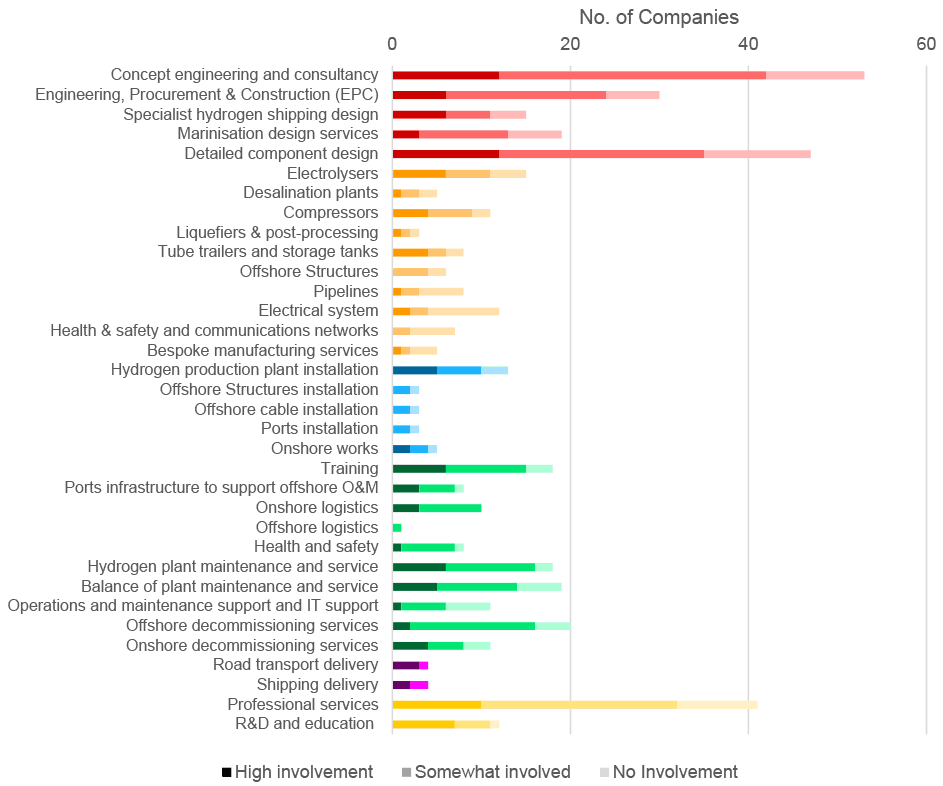
3.4.2.4 Tertiary Level Overview of Hydrogen Supply Chain
The tertiary levels of the hydrogen supply chain taxonomy (as shown in Table 3.5) are the products and services that companies may offer. This section analyses the companies that have stated an ability or desire to provide these products/services, considering each of the Primary stages of the supply chain in turn.
3.4.2.4.1 Development of hydrogen infrastructure
Figure 3.31 and Figure 3.32 show the number of companies that stated they would be able or interested in providing each of the products and services that comprise the ‘Development of Hydrogen Infrastructure’ stage of the hydrogen supply chain. In Figure 3.31, this was further broken down to represent how that company viewed its current level of involvement in the hydrogen supply chain at large, with darker shades representing ‘High involvement’ and lighter shades representing ‘No Involvement’. Figure 3.32 shows the areas in which the company has expressed current involvement. Please note that companies were able to select multiple experience areas and therefore may have been counted multiple times for each service offering.
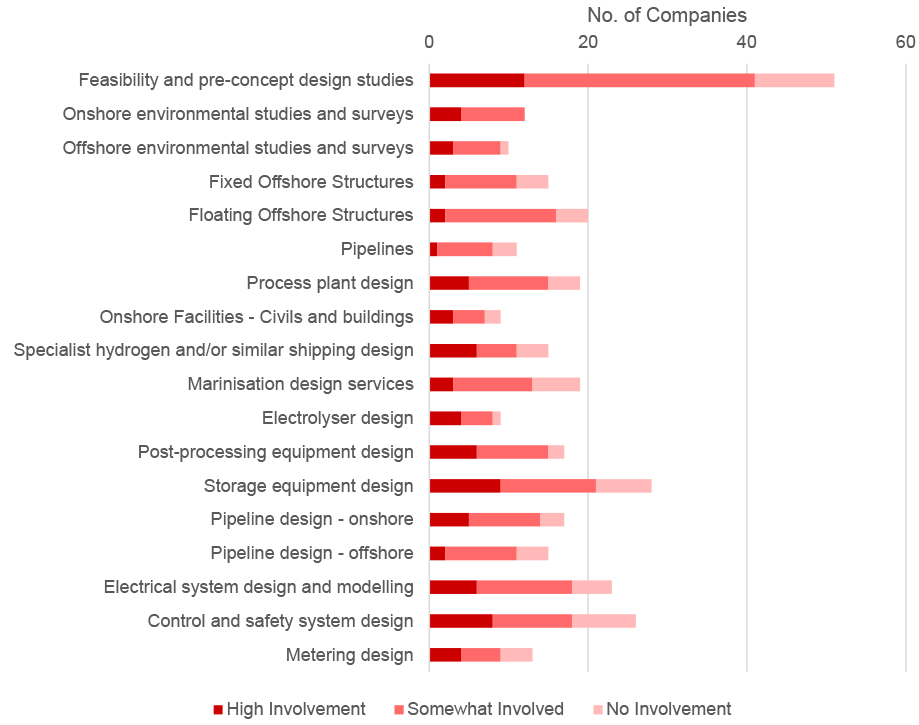
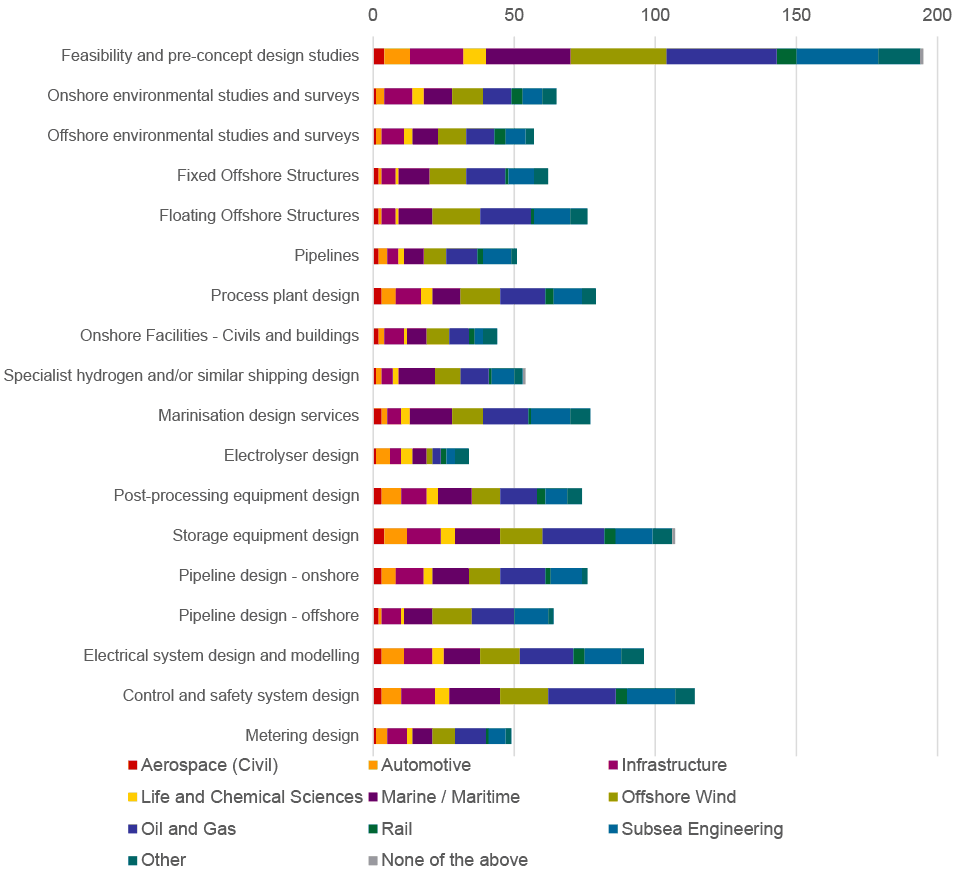
Almost half of survey respondents expressed an interest in providing ‘Feasibility and pre-concept design studies’, the most popular category within Development of Hydrogen Infrastructure. A high proportion of these companies (80% of those who expressed an interest in this area) consider themselves to be either highly or somewhat involved in the hydrogen supply chain. The second and third most popular choices were ‘Storage equipment design’ and ‘Control and safety system design’ respectively, and these also had the second and third highest number of companies considering themselves to be ‘highly involved’ in the hydrogen supply chain. This suggests that design capability is currently a particular strength of the Scottish hydrogen supply chain.
The areas with the least interest (in order from low to high) include ‘Electrolyser design’, ‘Onshore facilities – civils’, and ‘Pipelines’. This could be a result of uncertainty around exact hydrogen requirements resulting from the nascent state of the sector.
Figure 3.32 shows that companies willing to provide design services are predominantly coming from ‘Oil and Gas’, ‘Offshore Wind’, ‘Marine / Maritime’, or ‘Subsea Engineering’ backgrounds (in order of prevalence, from high to low). Indeed, this holds true for each of the tertiary levels within the ‘Development of Hydrogen Infrastructure’ supply chain stage.
3.4.2.4.2 Manufacture of Hydrogen Infrastructure
Far fewer companies expressed an ability or ambition to offer products and services in the Manufacture of Hydrogen Infrastructure than in Development. The category with the greatest interest was ‘Control and Monitoring Systems’ with a total of ten companies and twenty of the tertiary levels received no commitment at all.
Figure 3.33 shows the total number of companies offering each product/service within the Manufacture of Hydrogen Infrastructure stage as well as the perceived involvement of these companies in the hydrogen supply chain at large. There are some sizeable gaps in the supply chain; 20 areas have no companies able or aiming to provide services in them, and 10 areas were selected only by companies that do not perceive themselves to currently be involved with the hydrogen supply chain. Of these latter ten, the most popular were ‘Communication Systems’ and ‘Sensors and metering for electrical systems’. For categories where there is interest from companies that do not perceive themselves to be involved, there is an opportunity for engagement to turn ambition into action.
It is also possible to identify future strengths in the manufacturing supply chain, should companies’ ambitions be realised. For instance, categories that have been predominantly selected by companies that perceive themselves to be highly or somewhat involved in the hydrogen supply chain already. Examples include ‘Supply of fully assembled electrolysers’, Supply of fully assembled compressors’, and ‘Vessels for tube trailers and storage tanks’.
Figure 3.34 shows the number of companies per area of experience able or aiming to provide each product/service in the Manufacture stage of the hydrogen supply chain. It is important to note that for products that appear to be equally well supplied by each experience area this is normally the result of a small number of companies offering this product across many parallel supply chains (and being counted for each one), rather than many companies active in only one supply chain offering this. Companies with oil and gas, offshore wind, marine/maritime, or subsea engineering experience seem to be interested in providing services across Manufacturing, though are uniquely interested in providing offshore structures. Other service areas seem to attract interest from companies across the experience areas, suggesting products and experience in parallel supply chains are readily transferable to hydrogen developments.
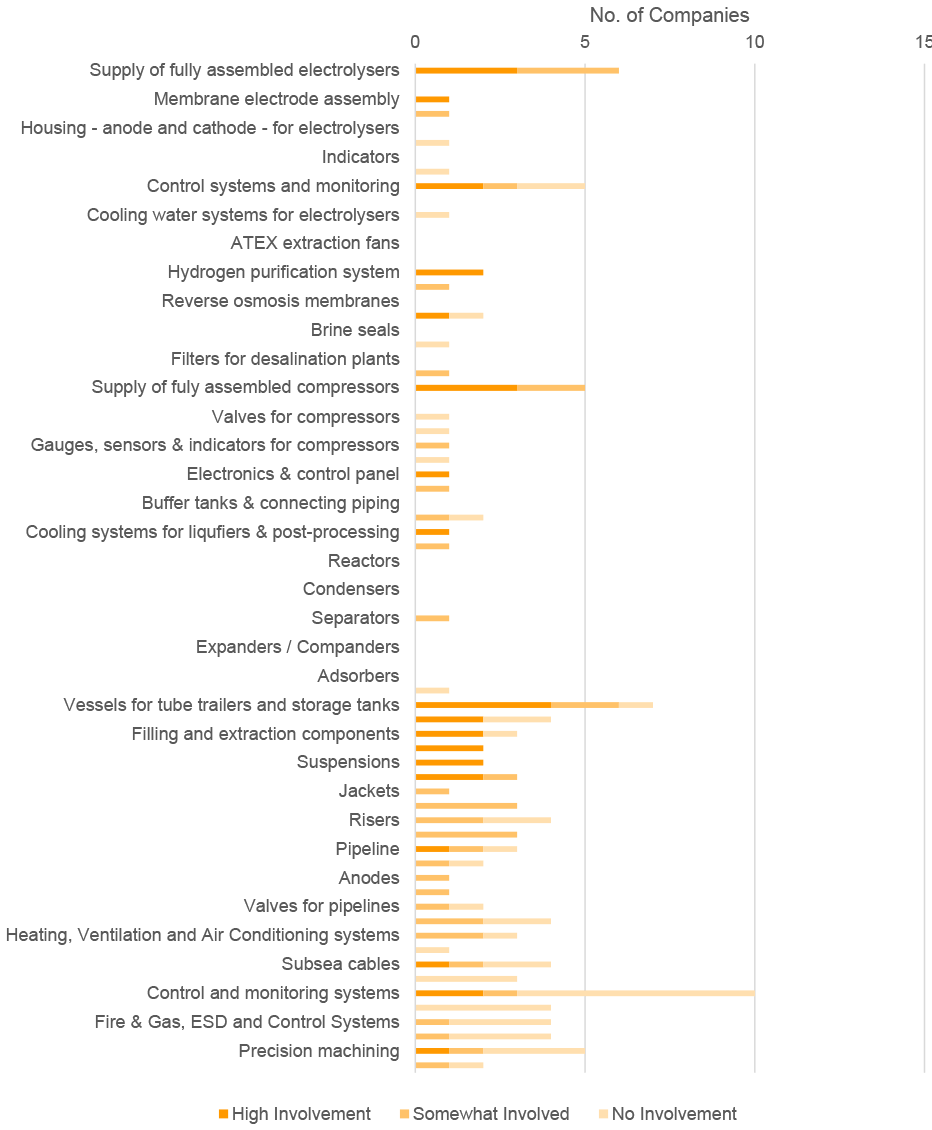
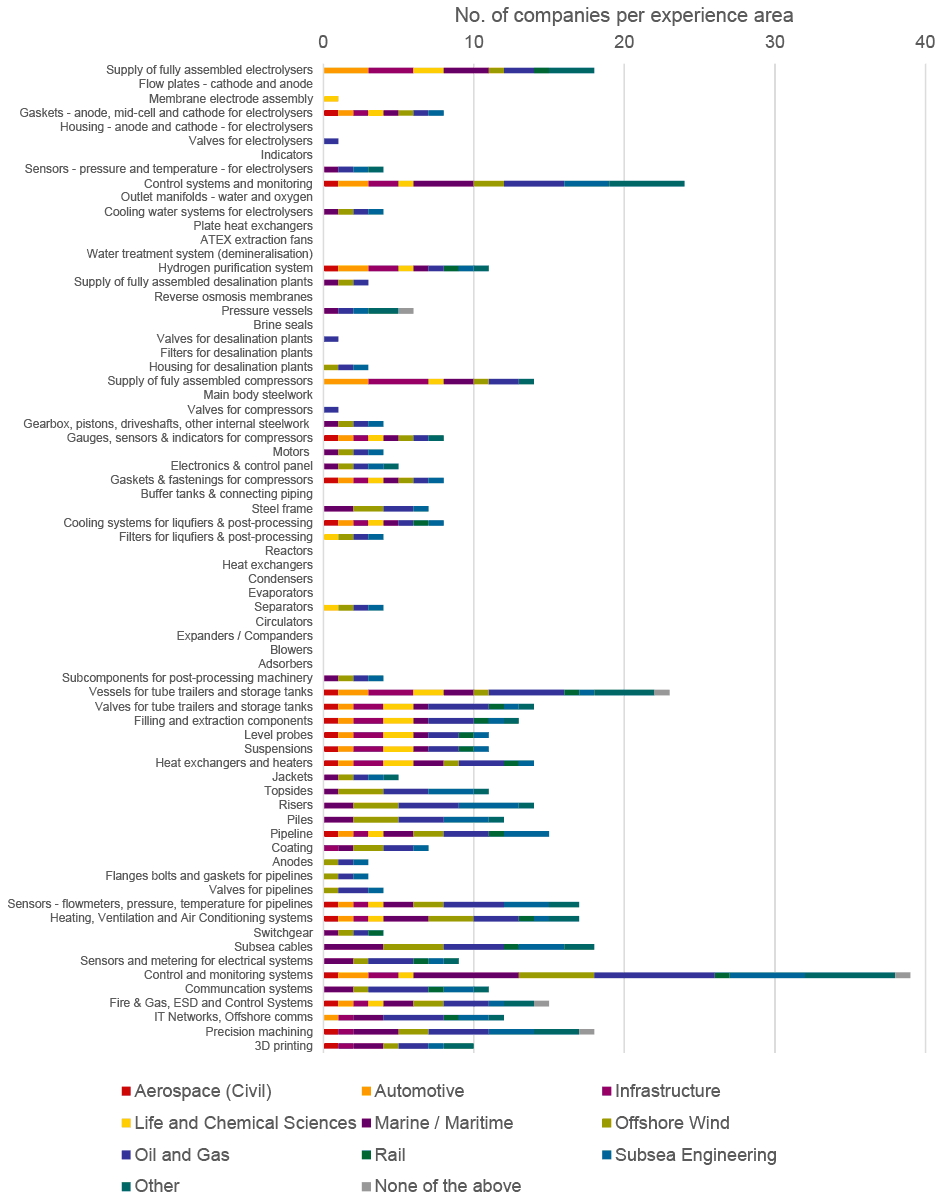
3.4.2.4.3 Installation and Commissioning of Hydrogen Infrastructure
A total of 20 companies stated they had an interest in providing services for the installation and commissioning of hydrogen infrastructure.
Figure 3.35 shows the number of companies willing to offer each of the 14 installation/commissioning services, broken down according to their perceived level of involvement in the overall hydrogen supply chain. The two most selected services are also the two areas preferred by companies that are either highly or somewhat involved in the hydrogen supply chain: hydrogen production plant installation, and commissioning. This suggests these areas are a strength of the Scottish hydrogen supply chain as it stands. The same two companies (both of whom perceive themselves to be ‘somewhat involved’), are interested in providing installation and commissioning services for many of the products/services in the installation stage. Early engagement with these companies could identify their exact capability and capacity to supply Scotland’s hydrogen sector and where they might need further support to grow supply as demand increases.
Figure 3.36 shows the parallel sectors in which these companies also have experience. Many of the companies are active across several parallel sectors, with no one area of experience standing out as being particularly well matched with this stage of the hydrogen supply chain. Companies active in the aerospace, automotive, and life and chemical sciences fields seem only to be interested in providing services that can be conducted onshore. Companies with offshore experience (e.g. in oil and gas, offshore wind, or subsea engineering) however seem comfortable offering services in both offshore and onshore environments.
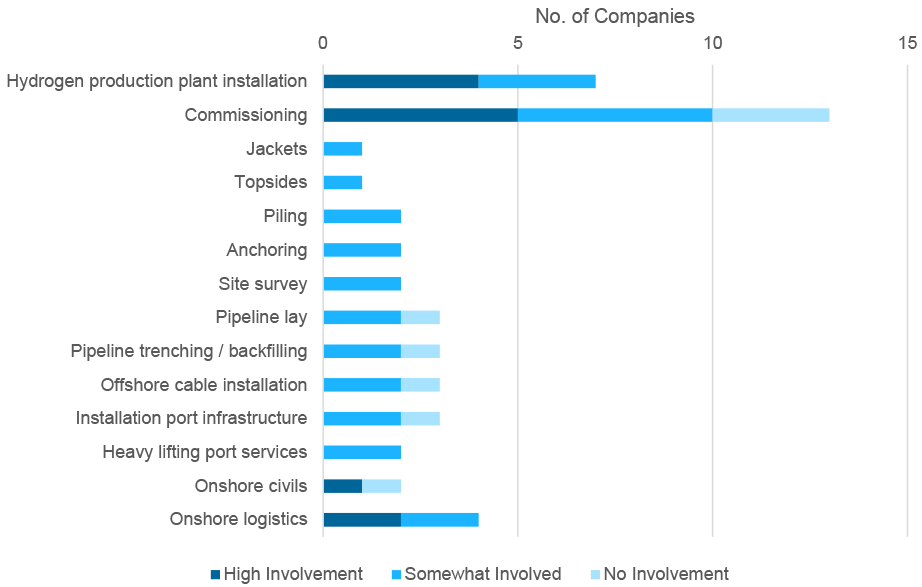
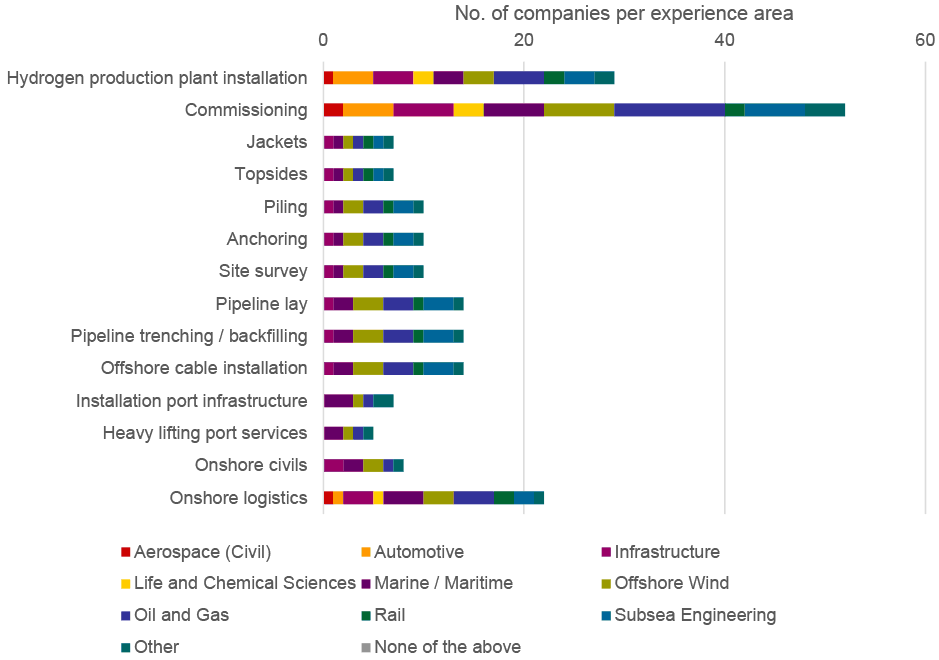
3.4.2.4.4 Operation, Maintenance, and Decommissioning of Hydrogen Infrastructure
50 companies (~46% of survey respondents) expressed an ability or ambition to provide products/services in the ‘Operation, Maintenance, and Decommissioning of Hydrogen Infrastructure’ stage of the hydrogen supply chain. There are some gaps in the supply chain, notably in provision of crew transfer vessels (where supply capability certainly exists in parallel sectors) and pipelines to export hydrogen overseas. The rest of this supply chain stage, however, seems to have numerous companies offering services, particularly in training, inspection and repair of various pieces of infrastructure, and offshore decommissioning services.
Figure 3.37 shows the number of companies able or aiming to provide each of the service areas in this stage of the hydrogen supply chain according to how they perceive their involvement in the supply chain at large. Areas with a high proportion of companies that don’t see themselves as involved can expose a weakness in the supply chain. For instance, offshore logistics seems to be a particularly underserved part of the supply chain with no companies offering services in CTVs or transport of hydrogen via subsea pipelines, and only one ‘somewhat involved’ company offering transport of hydrogen logistics via shipping services. On the other hand, areas with several highly or somewhat involved companies expressing an interest can be seen as a strength in the supply chain. Hydrogen plant and balance of plant maintenance and service are both areas with a strong offering, largely offered by the same 5 or 6 companies, as is Training.
Figure 3.38 shows the number of companies willing to supply each part of this stage of the supply chain according to the sectors in which they already have experience. Given that each service offering seems to attract interest from companies offering services across each of the experience areas, it seems that there is no one experience area that particularly lends itself to provision of operation, maintenance, and decommissioning services. Rather, knowledge and expertise from a range of parallel sectors can be leveraged and is transferable to this stage of the hydrogen supply chain.
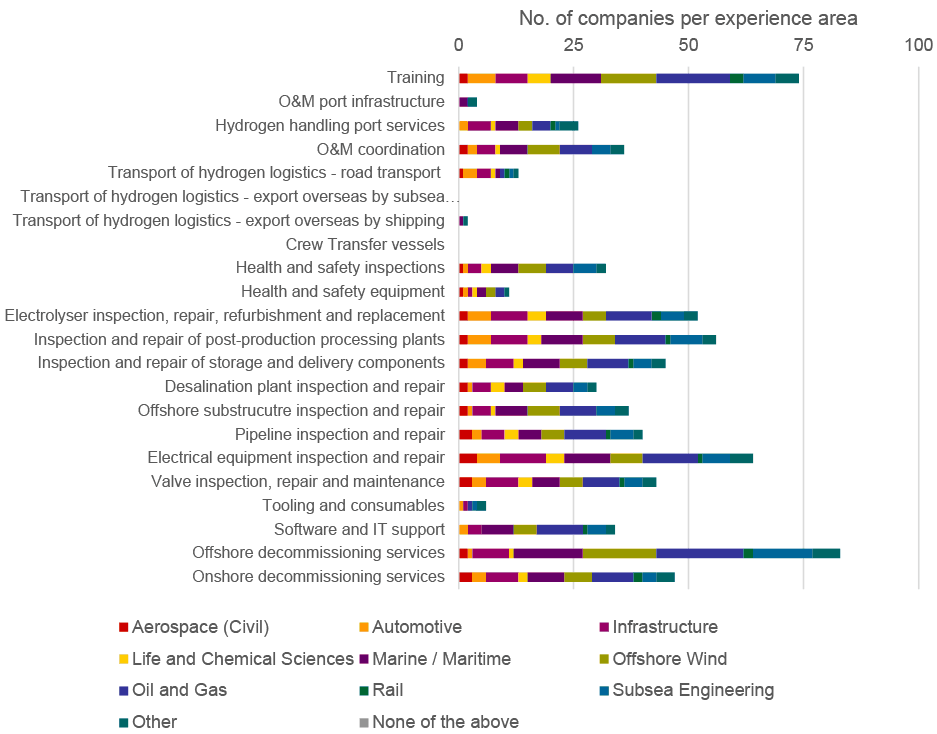
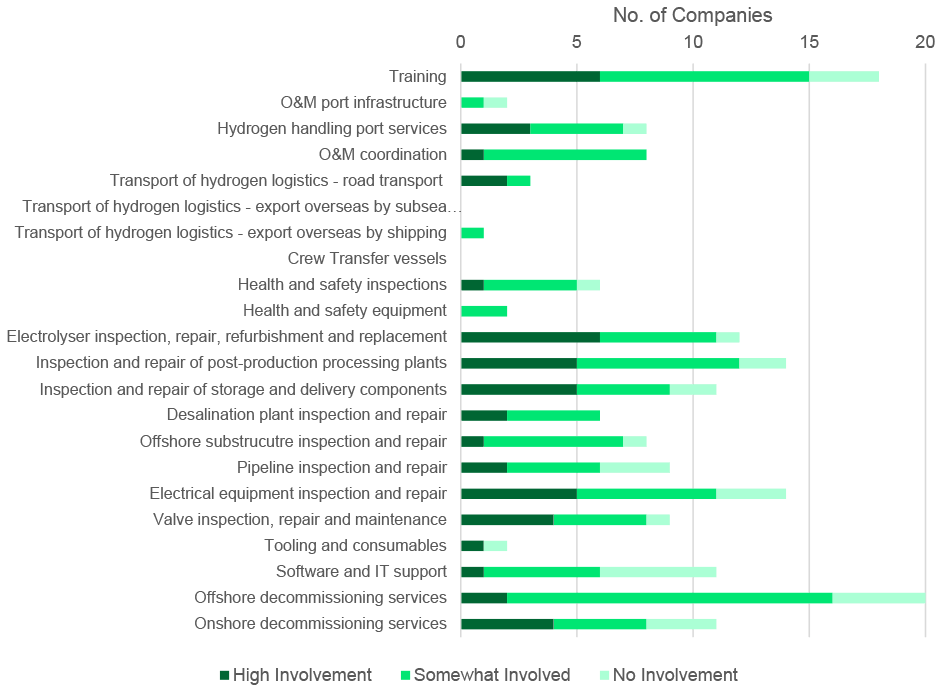
3.4.2.4.5 Transport of Hydrogen
Transport of hydrogen is the supply chain stage with the lowest number of companies able or aiming to provide services, with only four companies expressing an interest.
Figure 3.39 shows the number of companies willing to offer various types of hydrogen transport and their perceived level of involvement in the hydrogen supply chain. No companies that are currently not involved in the supply chain have expressed a desire to enter it as a transport provider. While the number of companies express ability or interest in offering rail, tankers, and other seagoing vessels is limited, it is surprising that a greater number of companies do not offer trucking services. This might be a result of the survey not reaching a wider array of companies that might be able to offer these services.

Figure 3.40 shows the sectors in which the companies willing to offer transport of hydrogen services are currently active. These companies seem to be active in numerous supply chains, which may be a comment on the areas to which they offer transport services rather than areas in which they have particular expertise. For instance, they might offer vessels suitable for use in the offshore wind and oil and gas industries but would not otherwise be involved with these developments.
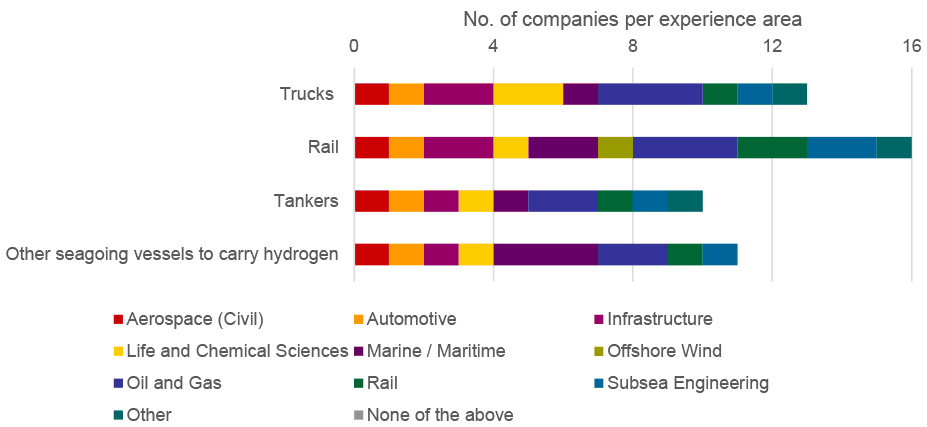
3.4.2.4.6 Sector Support Functions
47 companies expressed an ability or ambition to offer sector support functions in the hydrogen supply chain.
Figure 3.41 shows the number of companies offering each type of sector support function as well as their perceived level of involvement in the broader hydrogen supply chain. The most serviced sector support function is Consultancy, with 34 companies (roughly one-third of survey respondents) offering this service. Of these, 28 consider themselves to be either highly or somewhat involved in the hydrogen supply chain, suggesting that the supply chain is particularly strong in this area. Health and Safety bodies are well represented, as are research from non-academic institutions. The number of universities offering services was surprisingly low, suggesting that better engagement is required to raise awareness of potential areas of collaboration. No further education colleges responded to the survey. As these are the institutions that may provide training and courses to enhance the skills of the future hydrogen workforce, better engagement may be required to notify them of the needs of the hydrogen sector and to encourage development of training materials ahead of when these skills are required.

Figure 3.42 shows the experience areas of companies offering sector support services. Given that each service offering seems to attract interest from companies offering services across each of the experience areas, it seems that there is no one experience area that particularly lends itself to provision of sector support services. Rather, knowledge and expertise from a range of parallel sectors can be leveraged and is transferable to this stage of the hydrogen supply chain.
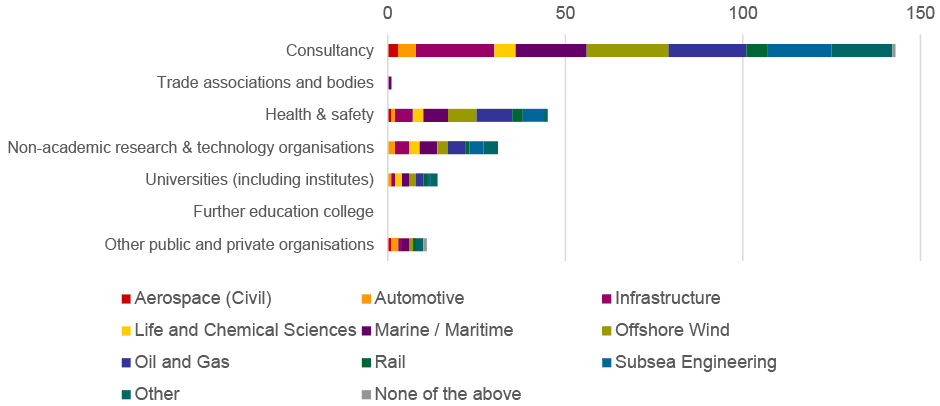
3.5 Assessment of Supply Chain Opportunity
3.5.1 Wider Scottish Supply Chain Capability Analysis
This study also considered the Scottish supply chain beyond the responses that were received through the survey to provide a more complete picture of the wider capabilities of Scottish firms. To achieve this, the green hydrogen supply chain taxonomy categories were cross referenced against those of the other Scottish Industry Directories to ensure that any capability to supply from those parallel sectors had been considered. The Scottish Industry Directories considered were: Aerospace (Civil), Automotive, Infrastructure, Life and Chemical Sciences, Marine/Maritime, Offshore Wind, Rail and Subsea Engineering. While there is no distinct Scottish Industry Directory for the oil and gas sector, some key capabilities are captured in the Subsea and Marine directories.
The assessment of the different aspects of the Scottish green hydrogen supply chain considered the current Scottish capability to supply each secondary category of the taxonomy, appraised on a scale of high, medium and low. High capability in a secondary category represents direct experience or experience that is largely applicable to the green hydrogen supply chain across the constituent tertiary categories. Medium capability represents a mix of direct or similar experience in some tertiary elements, with limited experience in other tertiary elements. Low capability means that there appear to be limited similar experience found in the majority of tertiary elements from parallel sectors.
3.5.1.1 Development of Hydrogen Infrastructure
| Supply Chain Area | Scottish Supply Capability | Parallel Industry Directories | Comments |
|---|---|---|---|
| Concept engineering and consultancy | High | Offshore wind, subsea | Feasibility studies, as well as onshore and offshore surveys are regularly conducted in parallel sectors. Supply chain is likely very capable of performing similar role in the hydrogen sector. |
| Engineering, Procurement & Construction (EPC) | High | Offshore wind, subsea, infrastructure | Considerable experience overlap with offshore wind and subsea sectors in construction of offshore fixed and floating structures. Infrastructure sector has similar, strong capability in onshore civils. |
| Specialist hydrogen shipping design | Medium | Marine | Ship design capability within the Scottish marine supply chain. Minimal experience of design for hydrogen shipping. |
| Marinisation design | High | Offshore wind, subsea, marine | Scale of Scottish offshore sector industries likely to result in good capability in marinisation design of equipment. |
| Detailed component design | Medium | Offshore wind, subsea, life and chemical science | Overlap with current capability for pipeline, electrical system and control and safety design in subsea and offshore wind sectors. Companies within the life and chemical sciences sector may have capability to provide some of the hydrogen-specific components. |
The development of hydrogen infrastructure capability shown in Table 3.6 predominantly consists of the design and engineering aspects of supply.
Generally, Scotland’s experience in offshore industries, including in the offshore wind, oil and gas, marine and subsea engineering sectors, means that there is already a relatively well-developed concept engineering consultancy and design supply chain ready to serve the hydrogen sector.
Specialist hydrogen shipping design is an area where capability may be lacking. Scotland has ship design experience, including experience in designing a hydrogen-fuelled vessel (Ferguson Marine’s involvement in the HySeas III project), but there appears to be a lack of existing supply chain capability in design vessels to transport hazardous substances.
Detailed component design is an area of mixed capability in the Scottish supply chain. There is some experience in pipeline, electrical system and control and safety design from the offshore wind, subsea and life and chemical science sectors. Bespoke hydrogen sector elements such as electrolyser design do not have clear parallels in these industries, however, the overlap in design and engineering skills may lead to capability being developed in the future.
Threats to the Scottish supply chain in these areas of limited current capability include specialist hydrogen shipping design being undertaken by current shipbuilding leaders, such as those in South Korea, China and Japan. Companies including Kawasaki Heavy Industries (Japan) and Global Energy Ventures (Australia) have already developed hydrogen shipping designs. The nature of the development of specialist hydrogen infrastructure also poses a potential threat as this supply does not require a local presence meaning that there are few obstacles to non-domestic suppliers providing strong competition to firms within the Scottish supply chain.
3.5.1.2 Manufacture of Hydrogen Infrastructure
| Supply Chain Area | Scottish Supply Capability | Parallel Industry Directories | Comments |
|---|---|---|---|
| Marinisation of equipment | Medium | Medium, subsea | No explicit supply in parallel Scottish Industry Directories although capability likely inherent from Marine and Subsea sectors |
| Electrolysers | Low | Life and chemical science | Limited experience. Life and chemical science supply chain may also be able to support (e.g. manufacture of water purifiers) whereas the offshore wind supply chain can provide sensors. |
| Desalination plants | Low | Aerospace, subsea | Limited experience. Some components, such as valves, are already part of the aerospace and subsea supply chains. Hydrogen-specific components, such as reverse osmosis membranes may require capabilities not yet present in Scotland. |
| Compressors | High | Offshore wind, subsea | Companies already present and manufacturing these components in Scotland as part of the subsea supply chain. |
| Liquefiers & post-processing | Low | Life and chemical sciences | Limited experience. Reactors are already produced by the life and chemical sciences supply chain. |
| Tube trailers and storage tanks | Medium | Life and chemical sciences, subsea | Some capability from parallel sectors in valves and heat exchangers. |
| Offshore Structures | High | Offshore wind, subsea | Capability exists from serving parallel sectors, although strong competition from non-Scottish suppliers has limited recent Scottish opportunity. |
| Pipelines | Medium | Aerospace, subsea | Good capability in some areas of pipeline manufacture, such as valves and gaskets, whereas other areas, such as fabrication of the pipeline itself, are limited. |
| Electrical system | Medium | Offshore wind, subsea | The Scottish supply chain has some experience in control and monitoring, sensors and switchgear. |
| Health & safety and communications networks | High | Offshore wind, subsea | Capability in supplying IT networks and communications, fire and gas, ESD and control systems. |
| Bespoke manufacturing services | High | Infrastructure, aerospace, infrastructure, subsea, offshore wind | Considerable experience in precision machining, in particular. |
The manufacture of hydrogen infrastructure primary category considers the capability of the Scottish supply chain in the production of components for the green hydrogen industry.
Scottish suppliers have good capability to supply in some elements, including compressors, offshore structures, health and safety systems and bespoke manufacturing services, because of their existing overlaps with other industry sectors.
The Scottish supply chain’s existing weaknesses in competitive manufacturing are revealed by the low number of companies with recent capability and experience in pipeline and offshore structure fabrication, where most of this kind of work is undertaken in England or outside of the UK because of cheaper costs. The requirements of manufacturing hydrogen-specific components may also be an obstacle where there is low capability in manufacturing components for liquefiers and post-processing, and in desalination plants. For the latter, the experience and capability to provide generic components such as valves is strong, but this is counterbalanced by the absence of manufacturing of specialist components. The lack of capability to manufacture specialist components is in part related to immaturity of the green hydrogen sector where it is challenging to ascertain potential future capability.
The lack of capability and experience in manufacturing is a threat to the future supply chain where other markets already have a comparative advantage through their existing manufacturing sectors. Simple manufacturing, as required for elements of pipelines and offshore substructures in the offshore wind and subsea sectors, is often done outside of Scotland by companies in Northern Europe or East Asia. This is unlikely to change without considerable support for Scottish industry that would make it more competitive on price.
Other countries have already developed their hydrogen-specific supply chain capability, particular competition should be expected from China, Japan, Germany and USA as they already have hydrogen infrastructure deployed whilst also already having considerable manufacturing expertise. Of particular note within the UK, ITM Power is rapidly emerging as a major electrolyser developer and manufacturer, but has no current presence in Scotland.
3.5.1.3 Installation and Commissioning of Hydrogen Infrastructure
| Supply Chain Area | Scottish Supply Capability | Parallel Industry Directories | Comments |
|---|---|---|---|
| Hydrogen production plant installation | Medium | Infrastructure | Little direct overlap with parallel industry directories, although some experience in Scotland likely in plant commissioning. |
| Offshore structures installation | High | Offshore wind, subsea | Direct experience of this within the Scottish supply chain from parallel sectors. |
| Offshore cable installation | High | Offshore wind | Direct experience from parallel sectors. |
| Pipeline installation | High | Subsea | Direct experience from parallel sectors |
| Ports installation | Medium | Marine, offshore wind, subsea | Direct experience from parallel sectors |
| Onshore works | High | Infrastructure | Large number of civil engineering firms present in the infrastructure supply chain. |
The Scottish supply chain has strength where capabilities from parallel sectors can be easily applied to the green hydrogen industry. Offshore structure, pipeline and cable installation are already integral parts of the requirements of the offshore wind and subsea sectors and the Scottish supply chain has evolved to meet this demand. From the infrastructure sector, there is also many firms who would be able to conduct onshore works. The similarity and direct experience of these processes means that it would be easy to transfer these skills to a green hydrogen context.
The capability of installation ports to meet the heavy lifting needs is an area that could be improved upon; capability is limited to certain locations across Scotland, but targeted investment could rectify this and provide good capability across the country. Conversely, Scottish installation ports are already under pressure from better equipped, foreign competitors in the offshore wind sector and failure to make investments in the necessary equipment could see Scottish ports bypassed by the green hydrogen sector in future, especially since installation and commissioning does not require a continued local presence.
Although several elements are strengths in this supply chain area, supported by Scotland’s experience in the offshore wind and subsea sectors, there are threats from neighbouring markets that currently have the same expertise and interest in offshore wind and subsea engineering. For example, Norway’s similar long history in the subsea sector means that their supply chain could feasibly present a strong challenge to Scottish companies if they innovate based on their current experience.
3.5.1.4 Operation, Maintenance and Decommissioning of Hydrogen Infrastructure
| Supply Chain Area | Scottish Supply Capability | Parallel Industry Directories | Comments |
|---|---|---|---|
| Training | High | Life and chemical sciences, subsea, offshore wind | Well-developed training and education sector. Potential to develop strong capability to provide training. |
| Ports operations | Medium | Marine, subsea, offshore wind | Extensive port infrastructure capable of handling operations and maintenance. Supply chain experience with oil and gas may also mean potential capability with hydrogen, but no direct hydrogen handling experience. |
| Onshore logistics | High | Marine, subsea, offshore wind | Extensive operations and maintenance experience. Direct experience of hydrogen road transportation in Orkney as part of Surf ‘n’ Turf/BIG HIT. |
| Offshore logistics | Medium | Marine, subsea | Only capability comes from experience acquired through oil and gas shipping. Minimal direct hydrogen experience of this kind. |
| Health and safety | High | Offshore wind, subsea | Direct experience from offshore wind and subsea sectors. |
| Hydrogen plant maintenance and service | Medium | Subsea | Inspection and repair experience of oil and gas installations will lend some capability. Well-developed O&G plant inspection supply chain already exists but experience of maintaining hydrogen-specific components yet to be established. |
| Balance of plant maintenance and service | High | Offshore wind, subsea | Direct experience of and well-developed supply chain for pipeline, electrical equipment and valve inspection and repair from parallel sectors. |
| Operations and maintenance support | High | Offshore wind, subsea | Software and IT support is already an integral part of parallel sectors. |
| Offshore decommissioning services | High | Offshore wind, subsea | Well-developed supply chain, in response to growing demand from oil and gas industry. |
| Onshore decommissioning services | High | Infrastructure | Well-developed supply chain in civils. |
Operations, maintenance and decommissioning of hydrogen infrastructure is an area of relative strength for the Scottish supply chain. Overlaps with the offshore wind, subsea and marine sectors mean that the supply chain for most of the secondary categories is potentially well-developed. The particular areas of strength include training, health and safety, balance of plant maintenance, onshore logistics, O&M support, and decommissioning.
The supply chain categories that require further capability development are in offshore logistics and hydrogen plant maintenance and service. These categories require experience with hydrogen-specific equipment and processes that are not yet commonplace, including transport of hydrogen logistics for the former and electrolyser inspection, repair, refurbishment and replacement for the latter. However, it is likely these services would be developed in Scotland in response to future project demand as there is logic to having these supplied locally.
The current advantage of the Scottish supply chain’s experience in operations, maintenance and decommissioning in parallel sectors presents an obvious opportunity for transition to future capability in the hydrogen sector. The investment required to make the transition is likely to be relatively minimal because of the similarity of the required services.
3.5.1.5 Transport of Hydrogen
| Supply Chain Area | Scottish Supply Capability | Parallel Industry Directories | Comments |
|---|---|---|---|
| Road transport delivery | Medium | - | Direct experience of hydrogen road transportation in Orkney as part of Surf ‘n’ Turf/BIG HIT. |
| Shipping delivery | Low | - | No evidence of Scottish capability in this field. |
Capability for road transport is scored as medium due to the experience of the Surf ‘n’ Turf/BIG HIT project in Orkney. There is no clear suggestion of capability from parallel sectors
There is minimal experience of shipping hydrogen in Scotland. Surf ‘n’ Turf currently transports hydrogen from Eday to Kirkwall, but this is done by road tankers on commercial ferries, which does not meet the taxonomy criteria.
The proximity of Scotland to competitor markets can be interpreted as both a supply chain opportunity and a potential threat. Hydrogen shipping companies, in particular, would not need to operate from Scotland or with a Scottish fleet in order to meet the supply requirement.
3.5.1.6 Sector Support Functions
| Supply Chain Area | Scottish Supply Capability | Parallel Industry Directories | Comments |
|---|---|---|---|
| Professional services | High | Offshore wind, subsea, infrastructure, life and chemical sciences, marine | Well-developed supply chain for a variety of professional services. Services already being provided to hydrogen sector. |
| R&D and education | High | Offshore wind, subsea, infrastructure, life and chemical sciences, marine | Scottish universities and research institutes already engaged in hydrogen-specific research. Supply chain has strong capability in this area. |
Scotland has a very well-developed sector support supply chain with a full range of professional services being provided to parallel sectors, as well as to the green hydrogen sector. Experienced consultancy services are provided by multiple organisations and Scotland already has its own hydrogen industry trade association in the form of the Scottish Hydrogen & Fuel Cell Association (SHFCA).
The Scottish education and research sector is similarly well-developed and is already engaged in hydrogen research, such as the University of Edinburgh’s HyStorPor project. The Scottish sector support supply chain is well placed to export this knowledge and capability to projects in other markets where physical presence may not be necessary to fulfil roles in this area. Similarly, failure to innovate and keep required capability in Scotland in future could also see sector support functions being carried out from outside the country. It is reasonable to assume that areas with rapidly developing hydrogen sectors, such as Japan, Australia, Germany and California, will also have increasingly well-developed sector support supply chains that could provide strong competition to the Scottish supply chain.
3.5.2 SWOT analysis
3.5.2.1 Strengths
Despite the infancy of the Scottish green hydrogen sector, its potential supply chain has several possible areas of strength. The green hydrogen supply chain has considerable overlap with elements of parallel sectors, most notably, the oil and gas, offshore wind and subsea engineering sectors.
The current strengths of the Scottish supply chain capability to support a potential future green hydrogen project are in areas of project development, installation, O&M and sector support where these can easily come from Scottish companies experienced in similar industries.
The strengths in the development of hydrogen infrastructure are in concept engineering and consultancy, EPC services and marinisation design. Here there are strong parallels with the established oil and gas, infrastructure, marine and subsea engineering sectors.
There are several strengths identified in the installation and commissioning of hydrogen infrastructure, notably in offshore structure, cable and pipeline installation that area key areas of the offshore wind and subsea engineering sectors.
In the O&M of hydrogen infrastructure, experience from the oil and gas, offshore wind and subsea engineering sectors in tertiary categories such as training, health and safety, and onshore and offshore decommissioning, means that a high level of capability already exists across the Scottish supply chain.
The Scottish supply chain is well placed to provide sector support functions to the green hydrogen sector based on high representation of consultancies, trade associations and research organisations with the capability to support industry growth. Many of these organisations are active in supporting sector development.
3.5.2.2 Weaknesses
Gaps in the Scottish supply chain are predominantly in supply areas bespoke to the design, manufacture and maintenance of hydrogen generation plant, where few companies have had the opportunity to gain direct experience to date. As with any nascent industry, supply for early projects is expected to come from companies operating in relevant parallel sectors. While there are several links between the potential hydrogen supply chain and those of similar industries, the supply of many products and services in those sectors are also non-Scottish.
Although the Scottish supply chain has some capability in component manufacturing and fabrication, this is seen to be weaker in supply areas that are bespoke to hydrogen generation infrastructure. Experience from supply to similar industries suggests many Scottish fabrication companies are less competitive on cost than non-Scottish suppliers and so it may be challenging to convert this into an area of strength.
Transportation of hydrogen appears to be an area with limited Scottish supply capability. Supply would be likely to come from companies with experience in the movement and handling of hazardous substances. However, this was the supply area with the fewest survey responses and no clear overlap with established supply capability from parallel sectors.
3.5.2.3 Opportunities
Opportunities exist where supply chain strengths can be leveraged. For the Scottish supply chain this will depend on the scale of the sector and may depend on whether the projects they are supplying to are in the domestic or export markets.
For domestic hydrogen projects there is a strong logic of local supply in inspection, maintenance and repair services as mobilisation costs offshore are significant, especially for pre-commercial projects. Local capability, vessels, and project management know-how is typically the most cost-effective solution. If a strong Scottish hydrogen sector develops then Scottish O&M suppliers will have a significant opportunity to benefit.
There are also opportunities for Scottish suppliers based on experience within the local supply chain where competitive advantage isn't based on location. This is applicable to elements of project development, such as hydrogen sector design and engineering, and many of the sector support functions. Where Scottish supply does exist, it is likely that developers will consider this a good opportunity for increasing local content.
There will also be opportunities in export markets where there is Scottish supply capability in areas that have no significant logistical benefit from using local supply, or where there are few logistical barriers to Scottish companies supplying oversees. In the manufacture and installation of hydrogen generation infrastructure and balance of plant Scottish companies will compete on an open market basis, relying on their track record and commercial offering. Where Scottish companies are experienced and can compete on quality, opportunities may open up in export markets if they can achieve attractiveness on cost.
Where there are gaps in the supply chain a significant hydrogen market could create an opportunity for investment in new capability to meet demand. A high requirement for hydrogen generation plant could attract a supplier to establish an indigenous pipeline manufacturing and associated hardware capability supply in Scotland, with good pan-European supply potential.
3.5.2.4 Threats
Some threats to the Scottish supply chain can be seen as the opposite of the opportunities, where established supply chains in competing markets take advantage of low barriers to supplying Scottish projects or have stronger experience and track record than Scottish suppliers.
The Scottish supply chain is particularly exposed to competition from stronger markets in manufacturing, where established fabricators in Europe can be more competitive on price whilst avoiding significant logistics costs or where hydrogen-specific manufacturing expertise is established outside of Europe. Should those countries also establish strong domestic markets then stronger supply chains for subcomponents and centres of excellence will likely appear around key infrastructure suppliers.
The prevailing threat to the Scottish supply opportunity may be in the lack of hydrogen generation projects being developed. The timescale for deployment of projects is less than certain and several years away. While the lack of current developments means there are limited opportunities for Scottish companies to demonstrate capability and develop track record, continued uncertainty over future project pipeline may deter suppliers from investing in facilities and technology and may inhibit supply chain diversification into the sector.
3.5.3 Summary
A database has been established of around 100 Scottish companies active in, or with an expressed interest in entering the green hydrogen sector.
- There is considerable hydrogen supply chain overlap with elements of parallel sectors, most notably, the oil and gas, offshore wind and subsea engineering sectors.
- The current strengths of the Scottish hydrogen supply chain are in the areas of project development, installation, Operations & Maintenance and sector support where these capabilities can be transferred from Scottish companies with experience in similar industries.
- Gaps in the Scottish supply chain are predominantly in supply areas bespoke to the design, manufacture and maintenance of hydrogen generation plant.
- Transportation of hydrogen appears to be an area with limited Scottish capability.
- The prevailing threat to the Scottish supply opportunity may be in a low pipeline of hydrogen generation projects.
- Established supply chains in competing markets may take advantage of low barriers to supplying Scottish projects or have stronger experience and track record than Scottish suppliers.
The Scottish supply chain is well positioned to support, and ultimately to benefit from, the development of green hydrogen. However, a steady pipeline of hydrogen developments over the next decade will be essential to ensuring the development of an indigenous supply chain so that Scotland is ready to deliver and take advantage of full commercial deployment.
3.6 Socioeconomic Assessment of Scotland’s Green Hydrogen Potential
3.6.1 Introduction
For this high-level analysis, the socio-economic impact framework used in the Sectoral Marine Plan was selected (summarised in Table 3.12). This framework of 15 indicators allows for assessment of the likely socio-economic impacts a development might have on an individual level, at a community level, and at a wider political and environmental level. This framework was selected as the three categories of fifteen indicators allows for a high-level but comprehensive socio-economic assessment (in line with the scope of this project) and it closely aligns with indicators used in the Scottish Government’s National Performance Framework (NPF). This latter quality is desirable as the NPF is used to measure Scotland’s progress towards achieving national values and outcomes and any policy that will improve performance will likely be looked upon favourably by policymakers and decision-making bodies. Demonstrating benefits according to indicators that align with the NPF is therefore beneficial to all sectors in Scotland as this can help show to what extent sector aims align with broader policy goals.
| Social Indicator | |
|---|---|
| Individual | Family, family life, and inter-generation issues |
| Jobs, career, and employment | |
| Money and cost of living | |
| Community | Local jobs, local industry, and community sustainability |
| Transport connections and technology connections | |
| Education | |
| Shops and housing | |
| Socialising, recreation, parks, and leisure | |
| Friends, being involved, and supporting others | |
| Local identity, cultural heritage, and Gaelic | |
| Healthcare | |
| Connection to nature and landscape | |
| Local political and decision-making systems | |
| Wider political and environmental context | Landscape, seascape, wildlife, and environmental change |
| National and EU level political and decision-making systems. |
3.6.2 Assessment
In this high-level assessment, the impact of developing green hydrogen is considered against each of the three clusters of indicators (see Table 3.12 for details). For each indicator, the likely impacts (both positive and negative) are discussed, drawing on insights from in-house expertise and available case studies.
3.6.2.1 Socio-economic impacts on Individuals
Individuals are likely to experience net positive socio-economic impacts as a result of green hydrogen development. These will primarily stem from the creation and retention of high-quality jobs. Jobs are likely to be created directly in the development and operations of both offshore wind farms and hydrogen production and transport facilities, and indirectly in the supply chain at large, as greater demand must be met with greater supply. Indeed, jobs are already being created. EMEC has developed in-house hydrogen expertise after investing in an electrolyser in 2015, which has since been used to produce the world’s first tidal-powered hydrogen. It has also facilitated EMEC partnering in a project – announced in 2018 – developing an all-in-solution to clean predictable energy generation, grid management, and production of hydrogen using excess capacity. As hydrogen gains prominence as an energy source, it is likely to be met with further role creation in policy also. For instance, the Orkney Islands Council has a dedicated Hydrogen Officer role which has been created as a result of local hydrogen developments such as the Surf ‘n’ Turf project. Jobs have also been created through the establishing of a specific hydrogen business unit in EMEC. Hydrogen developments in other councils would likely see the creation of similar roles.
The creation of high-quality jobs can have a positive impact on ‘Family, family life, and inter-generation issues’ in a number of ways. First, children stand to benefit from an increased standard of living as a result of their parents earning higher wages. Depending on the prior circumstances of their parents’ employment, this can have a positive impact on reducing child poverty and will generally result in improvements to child wellbeing. Second, many green hydrogen roles are likely to be created in remote, rural/coastal communities as these are often located close to better wind resources. Families in these communities can sometimes suffer as a result of family members having longer commutes to work or even having to migrate away from the area in search of employment opportunities. The creation of local roles can therefore have a positive impact through reduced commuting times (resulting in more free time for individuals that can be spent with loved ones) and through allowing individuals to remain close to family in the area e.g. grandparents.
As well as creating new jobs, green hydrogen developments could result in improved job retention through companies and their employees entering into the supply chain from parallel sectors, such as oil and gas. With dwindling North Sea oil and gas reserves and market demand as economies move towards net zero, long-term jobs in the oil and gas industry are declining and at risk. However, the knowledge and skills from this sector are transferable to other industries in the offshore energy space, including offshore wind and hydrogen. The development of green hydrogen from offshore wind therefore provides an avenue for workers to continue to use and develop skills learned from oil and gas, in line with just transition principles. It is important to note that this will not only affect workers employed directly by the oil and gas industry but will also provide a new source of income for the wider supply chain, including more service-based occupations such as consultancy.
Furthermore, the development of green hydrogen will provide a new source of income and need for services from ports. Not only will ports be required in the construction and installation of green hydrogen developments, but they could increasingly be used for green hydrogen exports to neighbouring markets and, potentially, for refuelling of ships, once hydrogen-powered shipping technology reaches maturity. Depending on demand, this could provide an additional source of income and employment opportunities for existing ports and could even require the development of new ports in more strategic locations for this new industry sector. As many Scottish ports have faced economic hardship following industrial decline, this could provide an avenue for alternative employment for remaining staff that allows them to continue to use and build upon skills developed thus far in their careers.
Regarding money and cost of living, job creation normally has a positive impact for individuals. However, it is important to take the baseline into consideration when determining if this is the case. While high-quality, well-paying jobs are expected from the development of green hydrogen, it is possible that these will not offer the same level of pay as could be expected in some parallel industries e.g. oil. Workers transitioning from oil into green hydrogen may experience a reduction in income, despite securing a high-quality job. For most new entrants to the sector, however, this is unlikely to be the case and will be experienced as a positive development. Cost of living is assumed to be largely unaffected, though there is a risk that it may rise slightly should the costs of new hydrogen technologies and infrastructure be passed onto consumers.
3.6.2.2 Socio-economic impacts on Communities
This section considers the likely impacts (both positive and negative) of green hydrogen developments on each of the ten Community indicators (see Table 3.12 for details), with each indicator considered in turn.
Green hydrogen developments are likely to have a positive impact on local jobs, local industry, and community sustainability. Local companies active in the green hydrogen supply chain could directly benefit from increased demand for their products/services. The retention and creation of high-quality, well paid jobs could positively benefit the broader local economy through increased local spend resulting from more disposable income. The local economy might further benefit from increased community sustainability (and hence a larger local market) that could result from local green hydrogen developments. For one, the creation of local jobs could result in a net inward migration to remote and rural areas and long-term, high-value jobs might incentivise families to settle. For another, new opportunities might facilitate increased population retention, with fewer people having to leave the community in search of employment elsewhere. As many communities are based around dominant industries, the development of green hydrogen projects in places based around parallel sectors (e.g. oil and gas) could have a particularly strong positive impact as these industries decline. Without viable alternatives, such communities can be entirely decimated, as happened in the 1980s following the closure of British coal mines. This would be entirely contrary to Just Transition principles.
The impact of green hydrogen projects on local transport connections and technology connections is likely to be minimal. Greater traffic congestion might result from greater travel to and from a site or an increased workforce. Any negative impacts, on either technology or transport connections, can be mitigated with advanced investment to expand local capacity.
The development of a new industry, such as green hydrogen, will likely have a positive impact on education within communities. For instance, universities, colleges, and further education facilities will have the chance to develop and enhance their course offerings to ensure students are gaining the necessary skills. Furthermore, through use of apprenticeships and training facilities, companies can enhance the skills of their workforce. For more rural and remote communities, improvements in community sustainability (as detailed above) and especially a growth in the number of local children could lead to greater support being offered for local schools as a result of the increase in demand for their services.
Local shops are likely to benefit from green hydrogen developments through introduction of new customers (if a site was previously unused) and through increased disposable income of existing customers (should they benefit from new employment opportunities).
Green hydrogen developments could positively impact both ‘Socialising, recreation, parks, and leisure’ and ‘Friends, being involved, and supporting others’. As mentioned before, the development of industries in rural, remote communities (where natural resource might be well-suited for green hydrogen developments) can result in net inward migration and improved population retention. This can result in the maintenance and development of strong bonds and relationships within the community. The larger population can also mean that recreation, parks, leisure, and other venues for socialising are used by more people.
Communities with an industrial heritage and historic links to offshore energy will likely benefit from green hydrogen as it reinforces a key aspect of local identity. The benefits will be particularly acute in areas that have suffered recent industrial decline, especially if residents are supported to gain the skills necessary to participate in the nascent green hydrogen sector. Outwith the Western Isles, green hydrogen developments are unlikely to have much of an impact on Gaelic. For Gaelic speaking regions, there is a risk that a large inward migration of non-speakers could reduce use of the language. However, should new families settle as a result of high-quality employment opportunities, it is possible that children will learn the language at school and from classmates.
Greater employment from green hydrogen developments is likely to have a positive impact on the physical and mental wellbeing of those employed and their dependents. Furthermore, the transition to green hydrogen and the use of hydrogen-powered vehicles is likely to have a positive impact on health through the reduction of harmful emissions.
The development of wind to green hydrogen systems in Scotland is likely to minimally impact people’s connection to nature and landscape. While the development of new offshore windfarms could meet with local opposition on visual pollution grounds, this is likely to be much lower than resistance faced by onshore wind as the wind farms are much more remote.
The extent to which local political and decision-making systems are impacted through the unlocking of Scotland’s green hydrogen potential depends, in part, on the manner and extent to which stakeholders are involved. Community energy projects, for instance, can result in the formation of new community-based decision-making bodies. In his 2019 paper ‘Winds of change: Legitimacy, withdrawal, and interdependency from a decentralized wind-to-hydrogen regime in Orkney, Scotland’, Michael Westrom examined the impact the Surf ‘n’ Turf project had had on local governance. The community-owned wind turbine earns revenue for the Shapinsay Development Trust and the distribution of this income “is capable of adding to, replacing, and shaping expenditures and policies enacted by local government”.
3.6.2.3 Socio-economic impacts on the Wider Political and Environmental Context
The unlocking of Scotland’s green hydrogen potential should significantly benefit efforts to reduce greenhouse gas emissions and contribute to global climate change mitigation targets.
Green hydrogen in Scotland has the potential to develop and enhance Scotland’s international reputation as a world-leader in renewable energy, with significant potential for export of goods and services to other interested regions.
3.6.3 Summary
Unlocking Scotland’s green hydrogen potential could result in numerous benefits at an individual, community, and wider political and environmental context. The main benefits are likely to result from job creation. In particular, jobs that are accessible to oil and gas and ports workers with transferable skills and experience will help prevent many of the negative impacts that would otherwise arise as a result of dwindling North Sea oil and gas reserves and market demand as economies move towards net zero. This is crucial for a just transition away from fossil fuels to be achieved. Likewise, the creation of high-quality, well-paying jobs in green hydrogen developments and the wider supply chain can encourage inward migration to an area or better population retention, as residents need not leave in search for work. This will be of particular benefit in remote, rural communities that have experienced shrinking populations as a result of the decline of industrial and more traditional industries.
Communities will also benefit from job creation as this will have concomitant benefits for local supply chain companies as well as local businesses that will benefit from the custom of a secure and growing workforce. The increased use of hydrogen as a fuel will likely have wider health benefits for communities due to reduced vehicle emissions and this in turn may encourage greater use of the outdoors for leisure and recreation, though this is likely to be minimal. If green hydrogen developments are located in areas formally dedicated to oil or gas processing, then this will have a positive impact on community stability as the workforce could be able to transition or grow, rather than having to leave to find work elsewhere should existing jobs decline. This could in turn bolster any sense of local identity rooted in an industrial past and heritage.
On a broader scale, the development of green hydrogen in Scotland could have a significant impact in Scotland’s role in reducing greenhouse gas emissions and could benefit Scotland’s international reputation as a leader in climate change action. Commitment to tackling emissions in heat and transport (following successful decarbonisation of the electricity sector) would demonstrate true commitment and leadership, which will be imperative for a successful COP26 in Glasgow in November 2021. There is also the potential for Scotland to become exporters of green hydrogen knowledge and technology, enhancing Scotland’s international reputation as well as generating revenue that might be used to the benefit of all Scottish citizens e.g. through increased public spending or reduced tax rates.
Contact
Email: onshoreoilandgas@gov.scot
There is a problem
Thanks for your feedback